With the 2017 NFL Draft now just over a week away, the Pro Football Focus analysis team takes a pass at all seven rounds. To accomplish this, we've assigned each analyst a team (with a few receiving multiple teams). We'll be making our picks for the first two rounds live on Tuesday and reveal our selections for Rounds 3–7 on Wednesday of this week. Be sure to follow all the action on Twitter (@PFF).

1. Cleveland Browns
Myles Garrett, Edge, Texas A&M
No need to overthink this one — the Browns grab the best player in the draft. Garrett has graded extremely well each of the past three years and battled a high ankle sprain for the majority of 2016. With 31 sacks and 35 hits in his career to go along with elite athleticism and a plethora of moves, Garrett will make an immediate impact and upgrade a Cleveland defense that struggled to generate pressure in 2016. — John Kosko, @PFF_JohnKosko
2. San Francisco 49ers
Mitchell Trubisky, QB, North Carolina
In an ideal world, the 49ers would trade down here. After failing to find a partner to dance with, though, common sense suggests that if you don't have a franchise quarterback, you shouldn't be passing on a potential one, so Trubisky is the pick. The one-year starter at North Carolina excelled when throwing the ball downfield, with 12 touchdowns to just one interception on throws 20 yards or further through the air. — Gordon McGuinness, @PFF_Gordon
3. Chicago Bears
Both Allen and CB Marshon Lattimore were in consideration here, but ultimately the depth at the top of the cornerback class led to Allen's selection as the best player available. Allen is capable of being an every-down defender as he was highly productive as both a pass-rusher and run defender in college. Allen's 67 total pressures led the nation among interior defenders and his 32 run stops ranked 11th in 2016. He helps solidify the Chicago front-seven, and we could be looking at a sub-package of pass-rushers featuring Allen, Akiem Hicks, Leonard Floyd, and a healthy Pernell McPhee next season. — Matt Claassen, @PFF_Matt
4. Jacksonville Jaguars
Marshon Lattimore, CB, Ohio State
The Jaguars stayed true to the big board and selected the top cornerback in the class, Marshon Lattimore. Opposing QBs only had a 30.2 passer rating when throwing into Lattimore's coverage in 2016. Pairing Lattimore with last year's first-round pick, Jalen Ramsey, will give the Jaguars one of the best young cornerback duos in the NFL, and a formidable force for years. — Jordan Plocher, @PFF_Jordan
5. Tennessee Titans from Los Angeles Rams
Corey Davis, WR, Western Michigan
The Titans had three targets with this pick: Marshon Lattimore, Corey Davis, and Mike Williams. The surprise pick of Lattimore by the Jaguars made this selection easy, as our war room values Davis slightly ahead of Williams. Western Michigan QBs had a 141.2 rating when throwing to Davis in 2016, the third-highest in all of FBS. — Josh Liskiewitz, @PFF_Josh
6. New York Jets
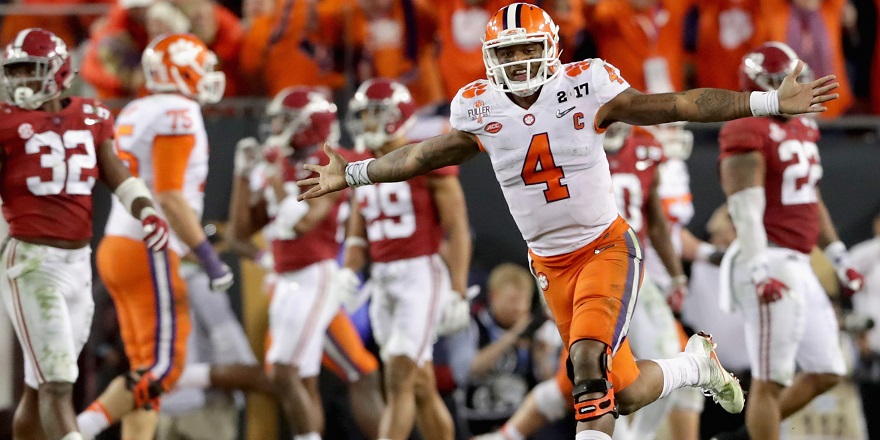
The Jets have been searching for a franchise QB for years, but haven’t taken a first-round signal-caller since 2009. Here, they select a player who has a chance to be something special. Watson is accurate, confident, dangerous with his legs, and has shown the nation that he doesn’t fold under the bright lights. His 83.2 PFF passing grade was tops among the draft class, while his 76.1 adjusted completion percentage ranked second. With a young and developing WR corps and offensive line, the Jets can build their offense specifically around Watson’s game. — John Gatta, @PFF_JohnGatta
[See Deshaun Watson's full scouting profile with a free preview of PFF Draft Pass stats here.]
7. Los Angeles Chargers
The Chargers are shifting to a base 4-3 defense under new defensive coordinator Gus Bradley, and that means some reshaping of the defensive personnel is required. Landing Malik Hooker is the first step. Hooker is a playmaking centerfield safety, the perfect fit for Bradley’s defense. While Hooker is raw, he still earned an 85.1 PFF coverage grade in his one year as a starter for the Buckeyes. — Kevin Connaghan, @PFF_Kev
8. Carolina Panthers
Derek Barnett, Edge, Tennessee
Barnett racked up 187 QB pressures in the last three seasons at Tennessee, converting 41 percent of those pressures into hits and sacks. A strong run defender all three years as well, with 80 run stops since 2014, Barnett can work as part of what would be a deep rotation immediately with the opportunity to take a lead role as short deals for Julius Peppers and Charles Johnson expire. — Ben Stockwell, @PFF_Ben
9. Cincinnati Bengals
Jamal Adams was PFF's top-graded safety in college, at 89.2 overall, and possesses the ability to play multiple positions in the defensive backfield. He plays a bit reckless at times, but missed just seven tackles in 2016 and made 33 defensive stops, seventh-best in the class. Our No. 5 overall prospect, the value was too good to pass up. — John Kosko, @PFF_JohnKosko
10. Buffalo Bills
The availability of Reuben Foster did not make this an easy decision, but ultimately the Bills went with the No. 1 receiver on the draft board. Williams' 3.34 yards per route run last season ranked second among all Power-5 wide receivers, and nobody in this class can win at the catch point like Williams can. The addition of Williams should provide a huge boost to Buffalo's passing game, along with some insurance in case Sammy Watkins is once again forced to miss action due to injury. — Billy Moy, @PFF_Billy
11. New Orleans Saints
Although the Saints acquired both A.J. Klein and Manti Te'o this offseason, inside linebacker still remains a need along with edge defender and cornerback. While the latter two positions have better depth in this draft, Foster is far and away the best and most complete linebacker in this class. Foster was the best linebacker against the run last year; he made a run stop on 16.3 percent of his run plays, which led all linebackers, while he did not allow a single touchdown in coverage, either. — Zoltán Buday, @PFF_Zoltan
12. Cleveland Browns from Philadelphia Eagles
Patrick Mahomes, QB, Texas Tech
The Browns drafted Cody Kessler in 2016. He showed promise as a rookie, but also has several question marks. With the most important position in sports still unsettled, the Browns take another swing at the plate at the player with the best arm talent to enter the NFL since Aaron Rodgers. With a PFF overall grade of 90.2 in 2016 and impressive accuracy (75.4 adjusted completion percentage) despite poor lower-body mechanics, Mahomes will need a year of development, but has the talent, instincts, and smarts to become the QB Cleveland has been looking for. — John Kosko, @PFF_JohnKosko
13. Arizona Cardinals
The Cardinals were hoping that Patrick Mahomes would fall to them here as the quarterback of the future, but with him going at No. 12, the Arizona makes a big impact on the defensive side of the ball. Opposing quarterbacks only had a 60.6 QB rating when throwing into White’s coverage in 2016, and his 12 pass breakups tied for third-most in FBS. Pairing another talented cornerback like White opposite of Patrick Peterson will allow the Cardinals to blitz to their heart's content. — Jordan Plocher, @PFF_Jordan
14. Philadelphia Eagles from Minnesota Vikings
Ross' injury history is a legitimate concern, but he's the one prospect capable of elevating the Eagles' offense instantly. A deep threat has been on the agenda for some time now in Philadelphia, and Ross represents this best option in this class (535 yards and seven touchdowns on 20-plus-yard targets). Howie Roseman loves drafting wide receivers early and Doug Pederson can get creative with the Washington wideout using his myriad of screens. The dropoff at the position behind the top three was also a factor in the selection. OT Ryan Ramcyzk and edge defender Solomon Thomas were also considered. — John Breitenbach, @PFF_John
15. Indianapolis Colts
Solomon Thomas, Edge, Stanford
We were not expecting to see Thomas still on the board, and had to make the move to get the reigning PFF College run stopper of the year. Thomas may not have a clean position fit at the next level, but we can trust him to at least play on the interior in sub-packages to bring that 92.5 grade against the run and continued work as a pass-rusher, where he finished at 87.7 last season. Thomas can dabble both at 5-technique defensive end in base packages and cross-train for a role on the edge. — Steve Palazzolo, @PFF_Steve
16. TRADE: Denver Broncos from Baltimore Ravens
[Trade details: Broncos receive pick No. 16 overall, Ravens receive pick No. 20 overall and Round 3 pick (No. 82 overall)]
The Broncos need all the tackle help they can get, and with a stockpile of picks, they used one to trade up for the top tackle in the class. Ramczyk's 84.6 PFF run-blocking grade was the highest among NCAA tackles in 2016, and he should be able to contribute in a big way for the Broncos out of the gate. — Bryson Vesnaver, @PFF_Bryson
17. Washington Redskins
Dalvin Cook, RB, Florida State
There is not a player in the draft that improves the Redskins' outlook on Day 1 more than Dalvin Cook. His vision and knack for hitting well-timed creases on stretch runs are a perfect match for what Washington wants to do in a largely zone-running scheme. Cook now gets to run behind a much better offensive line than he did in college, which should allow the back with the highest 2016 FBS elusive rating more time and space to operate. — Trevor Lynch, @PFF_Lynch
18. TRADE: New York Giants from Tennessee Titans
[Trade details: Giants receive pick No. 18 overall, Titans receive pick No. 23 overall and Round 3 pick (No. 87 overall)]
The Giants move up to instantly help the offense. Howard was the top-graded run-blocking tight end last season. He was also one of just four tight ends last year with 40-plus catches and at least 7.3 yards after the catch, giving Eli Manning another target to go along with Odell Beckham Jr., Brandon Marshall, and Sterling Shepard. — Nathan Jahnke, @PFF_NateJahkne
19. Tampa Bay Buccaneers
Christian McCaffrey, RB, Stanford
The versatile McCaffrey addresses the Buccaneers' need at running back, but this pick is about more than that. He has the skill-set to play (or fill in) at receiver, where the Bucs are currently lacking depth, and adds talent to the return game. In what some might call a “down year,” McCaffrey’s 2,329 total yards ranked third among RBs in 2016. — Bill Douglas, @PFF_Bill
20. TRADE: Seattle Seahawks from Baltimore Ravens from Denver Broncos
[Trade details: Seahawks receive pick No. 20 overall, Ravens receive pick No. 26 overall and Round 3 pick (No. 102 overall)]
Forrest Lamp, OG, Western Kentucky
With top O-line prospect Ryan Ramczyk off the board at No. 16, the Seahawks needed to move in order to secure one of the few top-tier linemen in this year’s draft. Lamp can fill in anywhere across Seattle's depleted line, and comes off a stellar 2016 season in which he allowed only four total QB pressures. — Harley Sherman, @PFF_Harley
21. Detroit Lions
The Lions considered moving up to secure McCaffrey or Reddick, so staying the course obviously paid off. Reddick is not just an explosive edge rusher, as he is excellent in all three phases of defense. He notched 44 total QB pressures last season and gave up a QB rating-against of just 46.8 on throws into his coverage. — Josh Liskiewitz, @PFF_Josh
22. Miami Dolphins
Jordan Willis, Edge, Kansas State
With Haason Riddick coming off the board the pick prior, this made the decision easier in selecting Jordan Willis. Willis is coming off a year in which he had 15 sacks, eight quarterback hits, and 57 hurries on 524 pass-rushing snaps. The addition of Willis will give the Dolphins a formidable rotation along the defensive front. — Steve Slowik
23. TRADE: New England Patriots from Tennessee Titans from New York Giants
[Trade details: Patriots receive pick No. 32 overall and Round 3 pick (No. 103 overall), Saints receive CB Malcolm Butler and Round 6 pick (No. 199 overall)]
[Trade details: Patriots receive pick No. 23 overall, Titans receive pick No. 32 overall and Round 3 pick (No. 103 overall)]
This was a huge need, and Lawson should have an instant impact as a pass-rusher for the Patriots. Lawson was a top target, and with the edge players going fast and furious in this draft, a trade up was needed to ensure New England got its guy. In 2016, Lawson had 47 total QB pressures from the left side, most in the FBS. — Louie Benjamin, @PFF_Louie
24. Oakland Raiders
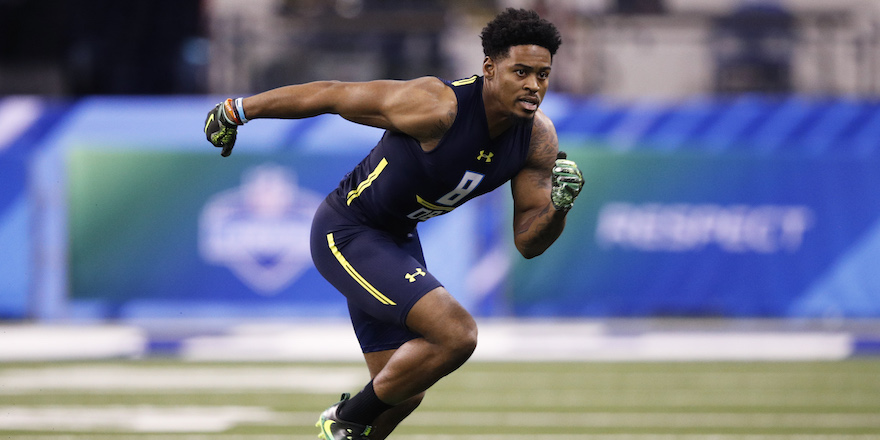
Conley is the best cornerback available at this point in the draft. David Amerson has been much-improved in Oakland, but is far too boom-or-bust to rely upon as a starter. Conley allows him to move to nickel and forms a formidable cornerback trio with Sean Smith. — Mike Renner, @PFF_Mike
25. Houston Texans
In terms of upside and physical talent, DeShone Kizer is on par with the top quarterbacks in this draft. He has a powerful arm, solid pocket instincts, and the ability to effectively push the ball downfield, posting a 111.5 QB rating on deep-pass attempts last season. Texans coach Bill O’Brien will have to work with him on his consistency issues, but Kizer has the ability to develop into the long-term answer at quarterback that Houston has been searching for. — Vinnie Ronca, @PFF_Vinnie
26. TRADE: Baltimore Ravens from Seattle Seahawks
[Trade details: Ravens receive pick No. 26 overall and Round 3 pick (No. 102 overall), Seahawks receive pick No. 20 overall]
The Ravens' defense needs a pass-rush injection, and they are still able to get one of the premier defenders in this draft class after moving down twice and picking up an additional two third-round draft picks. Williams averaged a pressure once every 4.9 pass-rushing attempts in 2016 and will give Baltimore an immediate pass-rush boost. — Gordon McGuinness, @PFF_Gordon
27. Kansas City Chiefs
With the top four quarterbacks off the board, the Chiefs select a right cornerback to start opposite All-Pro Marcus Peters. Lewis showed elite ball skills with six interceptions and 28 pass breakups over the past three seasons. He also has the ability to be productive when moved into the slot, as he allowed just 0.35 yards per coverage snap when lined up on the inside. — Mark Harrington, @PFF_Mark
28. Dallas Cowboys
Injuries limited Watt to a single season of starter snaps, but he more than made up for lost time. The Cowboys add size, speed, athleticism, and an obvious pedigree to a defense searching for an explosive presence off the edge. Facing Power-5 competition in 2016, Watt posted the fifth-best qualified pass-rushing productivity mark (18.1) in the nation, with 48 total quarterback pressures on 210 pass-rushing snaps. — Wes Huber, @PFF_Wes
29. Green Bay Packers
This was the Packers’ dream scenario in my “Mock Week” draft last week. Humphrey is a top-three cornerback in this class in my opinion, and the Packers need any sort of talent they can find at the position. — Mike Renner, @PFF_Mike
30. Pittsburgh Steelers
Charles Harris, Edge, Missouri
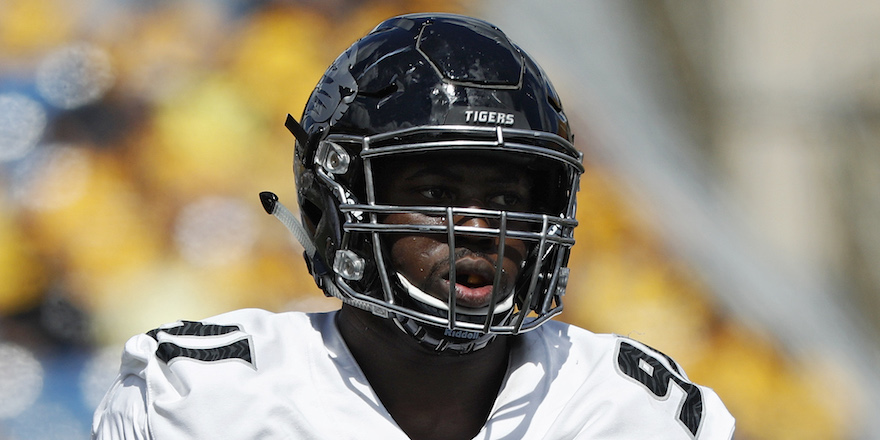
An instinctive pass-rusher with a variety of moves, Harris gives the Steelers an immediate impact getting after the passer in nickel packages. He will also be able to develop his game on the edge in base defense. — Zac Robinson, @Zac_Robinson5
31. Atlanta Falcons
Malik McDowell, DI, Michigan State
A no-brainer. Atlanta needs help on the edge, and Malik McDowell is the best player left on their board. He can play all downs, and has the potential to kick inside in obvious passing situations. McDowell is a great fit with the amount of stunts the Falcons like to use in those situations. — Khaled Elsayed, @PFF_Khaled
32. TRADE: Tennessee Titans from New England Patriots from New Orleans Saints via New England Patriots
[Trade details: Patriots receive pick No. 32 overall and Round 3 pick (No. 103 overall), Saints receive CB Malcolm Butler and Round 6 pick (No. 200 overall)]
[Trade details: Titans receive pick No. 32 overall and Round 3 pick (No. 103 overall), Patriots receive pick No. 23 overall]
Zach Cunningham, LB, Vanderbilt
With four third-round picks after two trade-downs from pick No. 18, the Titans have full confidence that they'll be able to dip into the loaded CB class later. Cunningham is a thumper who regularly destroys blockers in the run game, and has the physicality and athleticism to challenge tight ends in coverage as well. He finished fourth among all FBS inside linebackers last season in run-stop percentage, and will be a massive and immediate upgrade at ILB for Tennessee. — Josh Liskiewitz, @PFF_Josh

33. Cleveland Browns
A first-round talent, Jones drops to the second because of a partially-torn Achilles, but he could be ready by training camp. Jones excels in press- and in off-coverage, as he's allowed just one TD in the past two years while recording seven interceptions and 12 pass breakups. Even if Jones has a slower recovery than expected, the Browns — with all their picks — have the luxury of waiting for him to heal and will provide excellent value. — John Kosko, @PFF_JohnKosko
34. San Francisco 49ers
The 49ers strongly considered drafting Ohio State's Marshon Lattimore with the second-overall pick in the draft. After instead adding the quarterback of the future in Round 1, they go to the defensive side of the ball in Round 2. Jackson has good ball skills, with six interceptions and 19 pass breakups over the past three seasons. He'll also be an impact player on special teams, and was tied for the highest return grade in college football in 2016. — Gordon McGuinness, @PFF_Gordon
35. Jacksonville Jaguars
David Njoku gives the Jaguars a mismatch player in the passing game, as he is too big for cornerbacks and too fast for linebackers. Njoku averaged 16.2 yards per reception last season, and will bring a downfield element to the Jacksonville offense.— Jordan Plocher, @PFF_Jordan
36. Chicago Bears
Cordrea Tankersley, CB, Clemson
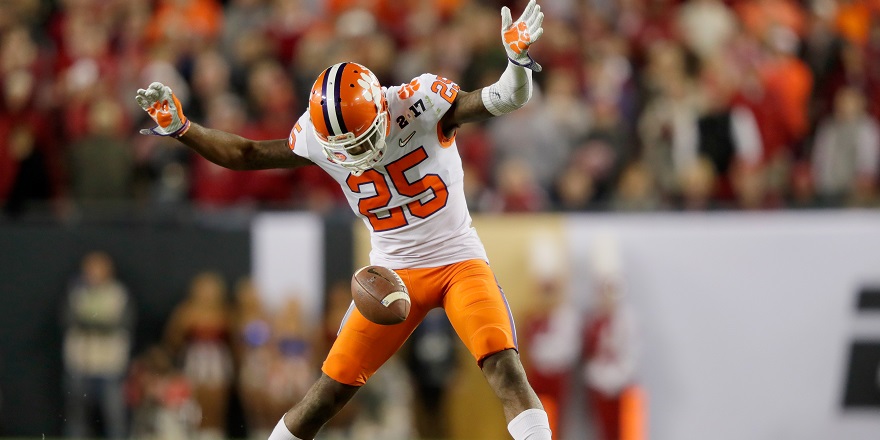
Chicago gets a scheme-diverse outside cornerback in Tankersley who will fit well in the mix of coverages the Bears like to deploy. In his two years as a starter, he allowed a completion percentage of 41.8 and a passer rating of just 40.7. He also made quite of few plays on the ball, with a combined 26 interceptions and pass breakups in two years. — Matt Claassen, @PFF_Matt
37. Los Angeles Rams
The Rams add a versatile defensive back to replace T.J. McDonald at strong safety. Melifonwu has ideal size and athleticism for the position, with experience both in the box and covering the deep part of the field, and even lined up at cornerback during the Senior Bowl. — Kiernan Hogan, @PFF_Kiernan
38. Los Angeles Chargers
Taylor Moton, G, Western Michigan
The Chargers need to do a better job of protecting QB Philip Rivers, and Moton can help them do just that. Moton earned an 83.5 grade as the Broncos’ starting right tackle in 2016, and an 85.4 grade as their starting right guard in 2015, giving up just one sack and five QB hits over both seasons combined. — Kevin Connaghan, @PFF_Kev
39. TRADE: Philadelphia Eagles from New York Jets
[Trade details: Eagles receive Round 2 pick (No. 39 overall) and Round 7 pick (No. 223 overall), Jets receive Round 2 pick (No. 43 overall) and Round 5 pick (No. 154 overall)]
King ticks every box as a prospect. He's long, athletic, and productive. Jim Schwartz needs corners to execute his press-man scheme and a minor trade up ensures he gets his man amid the run on corners in the second round. In his final year at Washington, King allowed a QB rating of only 55.6, suggesting shutdown potential for the NFL. — John Breitenbach, @PFF_John
40. Carolina Panthers
Fournette was stunning in 2015, finishing with the highest grade of any back in three years of PFF college grading (96.1 overall). Fournette broke 95 tackles on 319 touches, hitting double digits in five games. Fournette's power is an excellent fit for Carolina's running game. Cam Newton working read option plays off of Fournette will be a physical challenge for any team the Panthers face. — Ben Stockwell, @PFF_Ben
41. TRADE: Tennessee Titans from Cincinnati Bengals
[Trade details: Titans receive Round 2 pick (No. 41 overall), Bengals receive Round 3 pick (No. 83 overall), Round 3 pick (No. 87 overall), Round 5 pick (No. 163 overall)]
Ahkello Witherspoon, CB, Colorado
With CBs flying off the board at a high rate, it was time to put the currency accumulated in the first round to work. Witherspoon has outstanding size/speed measurables, and was a constant playmaker last season for Colorado. He broke up a total of 14 passes in 2016, tied for the fourth-most among FBS CBs. — Josh Liskiewitz, @PFF_Josh
42. New Orleans Saints
The Saints were trying to move down here to fill the gap between picks Nos. 76 and 196, but were unable to do so. Instead, they addressed their need of an edge rusher across from star pass-rusher Cameron Jordan. Charlton was the best available player on the board, as he is in the top 30 on the PFF draft board. The former Michigan defender can play on both sides, and while his snaps were limited, he was among the most effective 4-3 defensive ends last season, since his pass-rushing productivity mark of 16.6 ranked fourth in the nation. He recorded 50 total QB pressures on 238 pass-rushing snaps. — Zoltán Buday, @PFF_Zoltan
43. TRADE: New York Jets from Philadelphia Eagles
[Trade details: Jets receive Round 2 pick (No. 43 overall) and Round 5 pick (No. 154 overall), Eagles receive Round 2 pick (No. 39 overall) and Round 7 pick (No. 223 overall)]
Tabor has gotten knocked for his 40-yard-dash time, but his ability to change direction, anticipate, and close on routes is very impressive. He is a pass-breakup machine, recording either a pick or breakup on 26.5 percent of his targets. Over the past three years on passes thrown into Tabor’s coverage, he’s allowed only two TDs and an NFL passer rating of 41.2. For a team short of playmakers in the secondary, his ball skills and scheme versatility make for a near-perfect fit in New York. — John Gatta, @PFF_JohnGatta
44. Buffalo Bills
While the plan initially was to draft a cornerback here, the run that happened early in the round (six of 11 picks so far in the second round have been cornerbacks) presented an opportunity to zig while everyone was zagging. So instead, Buffalo addresses another area of need and picks up a true three-down linebacker. Davis has his flaws — he ranked 209th among all FBS inside linebackers with at least 400 snaps played in tackling efficiency last season — but his coverage ability makes him a Day 1 starter. If he can clean up his tackling, Davis has all the tools to become a Pro Bowl linebacker. — Billy Moy, @PFF_Billy
45. Arizona Cardinals
The Cardinals find their replacement for Larry Fitzgerald. Jones is sure-handed and only dropped 6 of 164 catchable passes in 2016. He is a well-rounded wide receiver who has the frame and playing style to fit right into Fitzgerald’s “big slot” position in the Cardinals' 11-personnel. — Jordan Plocher, @PFF_Jordan
46. Indianapolis Colts
Adding another defensive playmaker to the mix, Evans has the range to thwart passing attacks on the back end, where his 90.2 PFF coverage grade ranked third in the nation last season. He certainly has to improve as a tackler — he's missed 38 over the last two years — but Evans flies all over the field, and he's another important piece in Indianapolis' defensive overhaul. — Steve Palazzolo, @PFF_Steve
47. Baltimore Ravens
The Ravens traded starting center Jeremy Zuttah to the San Francisco 49ers earlier in the offseason, but land a starter from day one here in LSU's Pocic. An ideal fit in a zone scheme, Pocic earned the third-highest grade among all Power-5 centers in the nation in 2016. He comes with some positional versatility, given that he played 60 snaps at offensive tackle this past season, but would solidify the center position in Baltimore for the foreseeable future. — Gordon McGuinness, @PFF_Gordon
48. Minnesota Vikings
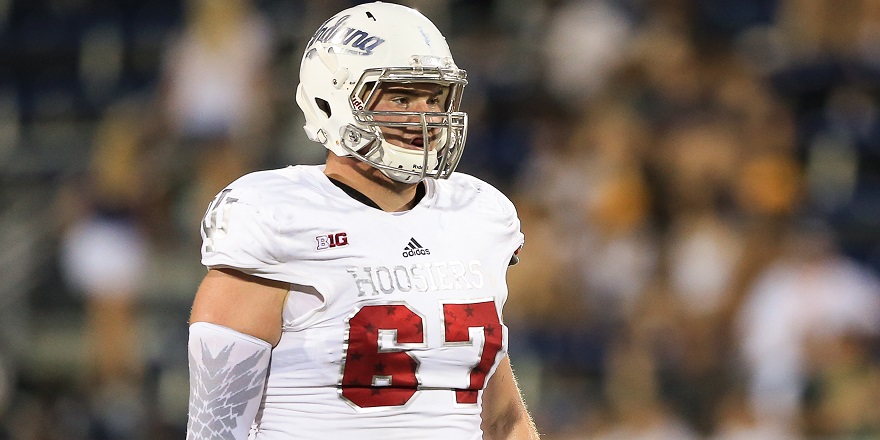
The Vikings addressed most of their critical needs in free agency, and several targets were snatched from them in the picks before they finally came on the clock, but Feeney sill gives Minnesota a player with a good shot to be a day-one starter at a position of need and upgrade the O-line. Playing a full season of guard in 2015, Feeney allowed just six total QB pressures and no sacks. — Sam Monson, @PFF_Sam
49. Washington Redskins
Washington responds to being torched by Cowboys RB Ezekiel Elliot twice last year by addressing the defensive line in need of an upgrade with one of the best run-stoppers in the class. Tomlinson accumulated 49 stops over three years at Alabama, with more than half coming in 2016. Tomlinson also provides position flexibility across the defensive front, as well as enough pass-rushing ability (43 QB pressures in 2016) to warrant three-down consideration. — Trevor Lynch, @PFF_Lynch
50. Tampa Bay Buccaneers
The end of the Dallas game showed us just how thin the Bucs are at tackle, and with this class being light at the position, Tampa Bay makes its move here. It might be a reach to fill a need, but Robinson has shown the ability to perform at a high level. After surrendering one sack, two hits, 10 hurries, and 11 penalties in 2016, he'll need to cut down on the mental lapses and penalties if he wants to challenge for a starting job as a rookie. — Bill Douglas, @PFF_Bill
51. TRADE: New York Giants from Denver Broncos
[Trade details: Giants receive Round 2 pick (No. 51 overall), Broncos receive Round 2 pick (No. 55 overall) and Round 6 pick (No. 206 overall)]
The Giants’ biggest loss in free agency was Johnathan Hankins, and Brantley would serve as a long-term replacement. He had a 11.26 percent run-stop percentage over the last three years, which was third-best for FBS interior defenders with 300-plus run snaps. He has also shown promise as an interior pass-rusher. — Nathan Jahnke, @PFF_NateJahnke
52. Cleveland Browns from Tennessee Titans
The Cleveland Browns had serious safety issues in 2016 that did improve at the end of the year, but the need still remains. Williams is a sure tackler — missing just five in 2016 and just 13 the past three seasons — while also providing excellent coverage numbers — ranking first in yards per coverage snap (0.09), coverage snaps per target (27.5), and coverage snaps per reception (58.9). Williams provides an excellent deep safety option that is aggressive but under control when coming forward toward the line of scrimmage. — John Kosko, @PFF_JohnKosko
53. TRADE: Houston Texans from Detroit Lions
[Trade details: Texans receive Round 2 pick (No. 53 overall), Lions receive Round 2 pick (No. 57 overall) and Round 5 pick (No. 168 overall)]
Only the Carolina Panthers have run the ball more than the Houston Texans over the last three seasons. With that sort of commitment to the run game, Bolles is the perfect fit to fill Houston’s need at right tackle. Bolles is one of the most physical linemen in the draft, works well in space, and ranked second among his peers with his 83.9 run-blocking grade last season. — Vinnie Ronca, @PFF_Vinnie
54. Miami Dolphins
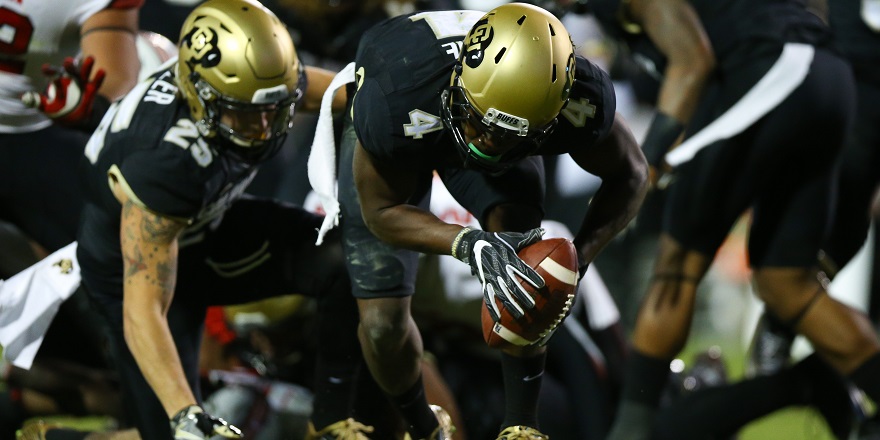
Awuzie has the ability to play outside and in the slot, as he should fit in nicely with the Dolphins’ scheme. At Colorado, he posted a PFF coverage grade above 80.0 for three straight seasons and recorded 15 passes breakups throughout that time. — Steve Slowik
55. TRADE: Denver Broncos from New York Giants
[Trade details: Broncos receive Round 2 pick (No. 55 overall) and Round 6 pick (No. 206 overall), Giants receive Round 2 pick (No. 51 overall)]
Gerald Everett, TE, South Alabama
The Broncos need to surround their young quarterbacks with dynamic receiving weapons, and that's exactly what they'll get with Everett. He's a bit raw, but he offers a ton with his physical tools and athletic ability, and showed some impressive after-the-catch ability. His 24 missed tackles forced led all TEs in 2016, as did his 22 in 2015. — Bryson Vesnaver, @PFF_Bryson
56. Oakland Raiders
The Raiders aren't excusing Mixon's past; rather, they're giving him a second chance. The Oklahoma back comes home to the Bay Area in what will surely be a controversial pick. He has as much talent as any RB in the draft, though, and immediately brings a dimension to the Raiders that they didn't have a season ago. — Mike Renner, @PFF_Mike
57. TRADE: Detroit Lions from Houston Texans
[Trade details: Lions receive Round 2 pick (No. 57 overall) and Round 5 pick (No. 168 overall), Texans receive Round 2 pick (No. 53 overall)]
This is an appropriate value here for a player that may take some time to find a home on defense, but will immediately be a top-five return specialist. He notched 30 defensive stops and 18 QB pressures last season, and tied with USC's Adoree' Jackson as the highest-graded returner in the country. — Josh Liskiewitz, @PFF_Josh
58. Seattle Seahawks
Rasul Douglas, CB, West Virginia
Cornerback is a need for the Seahawks regardless of whether Richard Sherman stays around, and here they pick a player who has the prototypical height and length that Seattle covets in its CBs. Douglas will need to work on his press technique at the NFL level, but brings with him superb ball skills, leading all CBs in this draft class with eight interceptions in 2016. — Harley Sherman, @PFF_Harley
59. Kansas City Chiefs
Vincent Taylor, DI, Oklahoma State
The Chiefs get a possible replacement for Dontari Poe in Taylor, who recorded 43 total QB pressures in 2016, tying him for 11th-most among interior defensive lineman. He had struggles with double-teams, but Chris Jones should help by taking some of those from Taylor. — Mark Harrington, @PFF_Mark
60. Dallas Cowboys
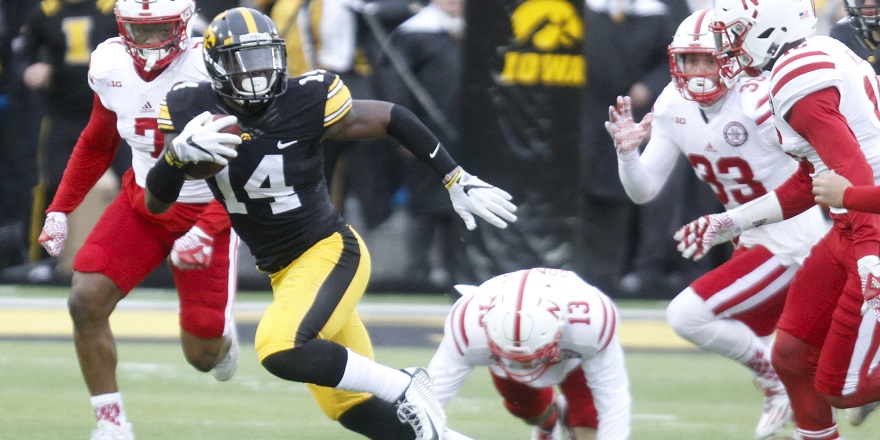
Dallas has an obvious need at cornerback, and the front office felt the difference between the No. 6 and No. 15 option was minimal. King posted a passer rating allowed under 50.0 over the last two seasons, permitting only four touchdowns, intercepting 11 targets, and deflecting 20 targeted passes. In addition, King returned 98 combined kickoffs and punts, providing the Cowboys with valuable versatility from their second-round selection. — Wes Huber, @PFF_Wes
61. Green Bay Packers
The Packers double-dip at corner just like they did in 2015. Even if Damarious Randall and Quinten Rollins both come good, they'll still need at least one other corner given how often Green Bay plays nickel and dime. Best to take two shots at finding that guy after how inept they were at the position last season. — Mike Renner, @PFF_Mike
62. Pittsburgh Steelers
After playing the least amount of man coverage in the NFL a season ago, the Steelers are in need of a player who can allow them to play more press man. Griffin is a tough, physical corner with good ball skills, capable of playing press man and challenging receivers on the outside. He allowed a passer rating of 63.4 when targeted last season. — Zac Robinson, @Zac_Robinson5
63. Atlanta Falcons
Takkarist McKinley, Edge, UCLA
The Falcons got production out of Dwight Freeney, but they need someone who at least situationally can add some explosion to their defensive front. McKinley might not play a huge deal early but can still make an immediate impact in sub package situations opposite Vic Beasley. — Khaled Elsayed, @PFF_Khaled
64. Carolina Panthers from New England Patriots
The Panthers use their tight ends extensively with Ed Dickson, a 2018 free agent, playing just shy of 500 snaps in 2016 as their No. 2 TE. Kittle would compete for snaps with Dickson immediately and should be an improvement as a run-blocker over the veteran. The former Hawkeye's athleticism at the combine was eye-catching and suggests an ability to contribute beyond the 61 targets he was afforded in 2015 and 2016 for Iowa. — Ben Stockwell, @PFF_Ben

65. Cleveland Browns
With contract negotiations with RB Isaiah Crowell at a stalemate, the Browns add an elusive three-down back in Toledo's Kareem Hunt. With 76 forced missed tackles in 2016 and the seventh best elusive rating at 112.4, Hunt possess power, vision, and agility to become an excellent back in the NFL. While he doesn't have breakaway speed, Hunt has excellent short-area quickness and elite ball security, with just two career fumbles and drops. — John Kosko, @PFF_JohnKosko
66. San Francisco 49ers
Samuel is the definition of an offensive weapon as a player who can line up in the backfield or as a receiver. His 2.76 yards per route run ranked second in this draft class, and with 425 snaps from the slot in 2016. He is the type of player that you just want to get in space and let him cause the opposing defense problems. — Gordon McGuinness, @PFF_Gordon
67. Chicago Bears
Xavier Woods, S, Louisiana Tech
The Bears signed Quintin Demps last month as their starting free safety, but he turns age 32 this summer. Woods has the potential be the long-term successor to Demps, and in the meantime, can see playing time as a slot cornerback, where he has significant experience in man coverage. Over the past three seasons, Woods picked off 14 passes and broke up another 10. — Matt Claassen, @PFF_Matt
68. Jacksonville Jaguars
Trey Hendrickson, Edge, Florida Atlantic
The Jaguars value college production, and Trey Hendrickson’s pass-rushing productivity mark of 20.5 ranks first in the draft class. Hendrickson generated one outside pressure per every 8.1 pass-rushing snaps, which also ranks first in the class. This could prove to be one of the steals of the draft. — Jordan Plocher, @PFF_Jordan
69. Los Angeles Rams
DeMarcus Walker, Edge, Florida State
Walker is a bit of a “tweener” on the defensive line, but he was one of the most productive pass-rushers in the country last season. Walker should be able to contribute immediately as an interior pass-rusher, and could also develop into an early-down edge-setter in base packages. — Kiernan Hogan, @PFF_Kiernan
70. New York Jets
Off-field issues aside, Westbrook is nothing short of explosive, with the ability to destroy people downfield with his speed. He has strong hands (four drops on 84 catchable throws in 2016) and the ability to play both outside and slot WR. While he will have to add some muscle to better take on press coverage, Westbrook’s body control, willingness to take on contact, and college production (4.08 yards per route run ranked second in draft class) provide the Jets with a playmaker with a lot of upside. — John Gatta, @PFF_JohnGatta
71. Los Angeles Chargers
The Chargers add an interior pass-rusher to help with transition to a base 4-3. Primarily a defensive end at Michigan, Wormley racked up 13 sacks and 83 total QB pressures over the past two seasons. He projects inside as a 3-tech defensive tackle for the Chargers. — Kevin Connaghan, @PFF_Kev
72. TRADE: Tennessee Titans from New England Patriots via Carolina Panthers
[Trade details: Titans receive Round 3 pick (No. 72 overall) for Round 3 pick (No. 100 overall) and Round 3 pick (No. 103 overall).]
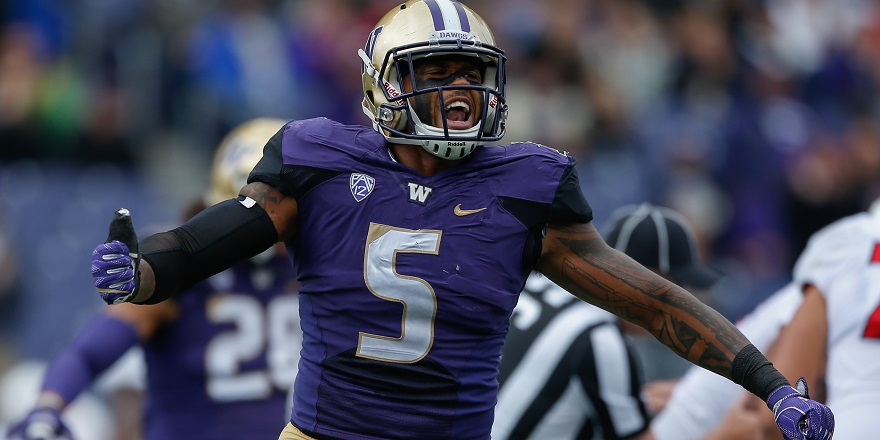
With Orakpo turning 31 this summer and in the final two years of his contract, it was important for the Titans to tap into this deep edge class. Mathis may not be able to offer much this season, but had he been healthy, PFF likely would have valued him in the late first or early second round. He racked up an impressive 30 total QB pressures in 2016 before injuring his knee in Week 6. — Josh Liskiewitz, @PFF_Josh
73. TRADE: Oakland Raiders from Cincinnati Bengals
[Trade details: Raiders receive Round 3 pick (No. 73 overall) for Round 3 pick (No. 88 overall) and Round 4 pick (No. 129 overall)]
Cooper Kupp, WR, Eastern Washington
The Raiders trade up to round out what will be the NFL's most explosive offense in 2017. Kupp can step in and contribute in the slot to any passing offense immediately. Grabbing him this late in the draft is a steal. — Mike Renner, @PFF_Mike
74. Baltimore Ravens (from Philadelphia Eagles)
While Elflein played center in 2016, he graded better at guard (82.8 compared with 80.1) in 2015. With Pocic already in the fold from Round 2, Elflein would be able to showcase his strength at guard. With position versatility in Alex Lewis, who is already on the roster, and the two selections early in this draft, the Ravens should feel pretty good about the youth on their offensive line. — Gordon McGuinness, @PFF_Gordon
75. Buffalo Bills
After passing on a CB in Rounds 1 and 2, it was imperative to address the issue before the wait to pick No. 155. Elder was the top cornerback remaining on the draft board, and can step in and be a day-one starter for Coach McDermott's defense in the slot. Buffalo's scheme should also afford Elder at least the opportunity to audition for a role on the outside. Elder was quite productive in college (his 0.79 yards allowed per coverage snap ranked 15th among the 79 draft-eligible Power-5 cornerbacks), and he's impressive in zone coverage, where he shows an ability to quickly process a play in front of him and an ability to react in time to force incompletions. If Elder does kick inside to the slot, one of the benefits is his strong ability against the run; he knows where he's supposed to be, and is a sound tackler, finishing last season with 66 solo tackles (eighth-most among all cornerbacks) while missing just four. — Billy Moy, @PFF_Billy
76. TRADE: Detroit Lions from New Orleans Saints
[Trade details: Lions receive Round 3 pick (No. 76 overall) and Round 6 pick (No. 196) for Round 3 pick (No. 85), Round 5 pick (No. 164), and Round 5 pick (168).]
Kamara is a great fit in Detroit because not only does he excel at setting up blocks and finding cutback lanes, making him perfect for Detroit's scheme, but he also brings excellent experience and value in the receiving game. He forced 49 total missed tackles last season (rushing and receiving), finishing sixth in elusive rating among FBS backs with at least 100 combined touches. — Josh Liskiewitz, @PFF_Josh
77. Arizona Cardinals
Zane Gonzalez, K, Arizona State
Mistakes in the kicking game were a big reason for the 2016 Arizona Cardinals failure to make the playoffs. The selection of Zane Gonzalez solidifies the kicking game in Arizona for the next 10 years. Gonzalez was perfect on field goals inside 50-yards last year and routinely kicks touchbacks. — Jordan Plocher, @PFF_Jordan
78. Baltimore Ravens
On offense, the Ravens need to come out of this draft with two things: offensive linemen to keep Joe Flacco upright, and pass catchers to make plays. Godwin is good at the latter, and what he excels at make him a solid fit for the Ravens. He can outmuscle defenders at the catch point, using his body to keep defensive backs off of him. Had a lot of success downfield in 2016, with 14 receptions for 504 yards and seven touchdowns on throws 20-plus yards downfield. — Gordon McGuinness, @PFF_Gordon
79. Minnesota Vikings
Minnesota is a team that cycles through a variety of different coverages, and while the Vikings have one safety that can execute that extremely well in Harrison Smith, they have now added a second in Washington prospect Budda Baker. Baker has the ability to excel in Mike Zimmer's defense and patch up a weak link in the chain. — Sam Monson, @PFF_Sam
80. Indianapolis Colts
This was a pure value pick, as Engram wasn't expected to be available at this point. He's one of the better playmaking offensive weapons in the draft, creating mismatches for defenses with WR-like route running. Engram led all draft class tight ends with 2.59 yards per route and 44 receptions for 685 yards coming out of the slot. — Steve Palazzolo, @PFF_Steve
81. Washington Redskins
A four-game suspension to OLB Trent Murphy and a disappointing first two seasons from OLB Preston Smith, who generated a pressure percentage of just 8.2 last year, lead to addressing the position opposite starting edge defender Ryan Kerrigan. Smoot's 52 total QB pressures from the left side ranked third-most in the draft class, and will help a team that struggled on third down last season. — Trevor Lynch, @PFF_Lynch
82. TRADE: Baltimore Ravens from Denver Broncos
[Trade details: Ravens receive Round 1 pick (No. 20 overall) and Round 3 pick (No. 82 overall) for Round 1 pick (No. 16 overall).]
Carlos Henderson, WR, Louisiana Tech
After grabbing a wide receiver at pick 78, the Ravens go back to the well again here. This is a deep wide receiver class and they have a lot of value at this point in the draft. Henderson would be different to the other receivers on the Baltimore roster, and can do serious damage fater the catch after forcing 48 missed tackles in 2016. — Gordon McGuinness, @PFF_Gordon
83. TRADE: Cincinnati Bengals from Tennessee Titans
[Trade details: Bengals receive Round 3 picks (Nos. 83 and 87 overall) and Round 5 pick (No. 163 overall) for Round 2 pick (No. 41 overall)]
Deatrich Wise Jr., Edge, Arkansas
A perfect fit for the Bengals' defense, Deatrich Wise has length and athleticism to combine with solid production off the edge. He has excellent power, as shown in his ability to win with bull-rushes (second in the class with 28.7 snaps per bull-rush pressure), but there are concerns about a decline in play from 2015 to 2016. With good hand usage and timing, Wise should benefit the Bengals early in his career. — John Kosko, @PFF_JohnKosko
84. Tampa Bay Buccaneers
Derek Rivers, Edge, Youngstown State
Rivers has all the physical tools to develop into a quality edge rusher. Similar to Noah Spence last year, he enters the draft with some raw and underdeveloped technique. The Bucs look for similar success with Rivers, hoping to add some edge pressure opposite Spence. — Bill Douglas, @PFF_Bill
85. TRADE: New Orleans Saints from Detroit Lions
[Trade: Saints receive Round 3 pick (No. 85 overall) and Round 5 picks (Nos. 164 and 168 overall) for Round 3 pick (No. 76 overall) and Round 6 pick (No. 196 overall)]
Bucky Hodges, TE, Virginia Tech
Hodges is more of a project at this point, but the fact that his playing style is similar to Jimmy Graham's makes him a good fit for the Saints. While his blocking skills need to be developed, Hodges can already be relied upon as a receiver, especially since he played that position in 2016. Furthermore, he finished the year with 12 receptions on deep passes (targets thrown 20-plus yards in the air), which ranked 23rd among wide receivers. — Zoltán Buday, @PFF_Zoltan
86. Minnesota Vikings
Minnesota suddenly has a significant hole to fill along the D-line with Sharrif Floyd's injury reportedly one that could threaten his career. At the minimum, the Vikings could use another presence inside rushing the passer. Smart notched 47 total QB pressures in 2016. — Sam Monson, @PFF_Sam
87. TRADE: Cincinnati Bengals from Tennessee Titans via New York Giants
[Trade details: Bengals receive Round 3 picks (Nos. 83 and 87 overall) and Round 5 pick (No. 163 overall) for Round 2 pick (No. 41 overall)]
Taywan Taylor, WR, Western Kentucky
With the Bengals needing an upgrade at WR opposite of A.J. Green, they opt for the electric Taywan Taylor from Western Kentucky. With elite quickness (6.57-second 3-cone) and the most deep receiving yards (948) in FBS in 2016, Taylor provides a threat at all levels of the defense. — John Kosko, @PFF_JohnKosko
88. TRADE: Cincinnati Bengals from Oakland Raiders
[Trade details: Raiders receive Round 3 pick (No. 73 overall) for Round 3 pick (No. 88 overall) and Round 4 pick (No. 129 overall)]
The Bengals have major needs on the offensive line, especially at both tackle positions. They opt for an interior chess piece that can play either guard or center. Grading as one of the best guards in the nation in 2015, Roullier made a position switch to center and played well. Allowing just one sack and two hits the past two years combined, Roullier will compete for a starting position at either center or right guard, with Russell Bodine struggling (though improved in 2016) and the departure of Kevin Zeitler in free agency. — John Kosko, @PFF_JohnKosko
89. Houston Texans
In need of an impact player on the back end of their defense, the Texans grab the nation’s top-graded coverage safety in Colorado’s Tedric Thompson. Opposing QBs had a rating of just 21.3 when targeting Thompson last season, and his superior ball skills helped him rank among the top three in the nation in both interceptions (seven) and pass breakups (seven). — Vinnie Ronca, @PFF_Vinnie
90. TRADE: Philadelphia Eagles from Seattle Seahawks
[Trade details: Eagles receive Round 3 pick (No. 90 overall) for Round 3 pick (No. 99 overall) and Round 6 pick (No. 193 overall)]
Roderick Johnson, OT, Florida State
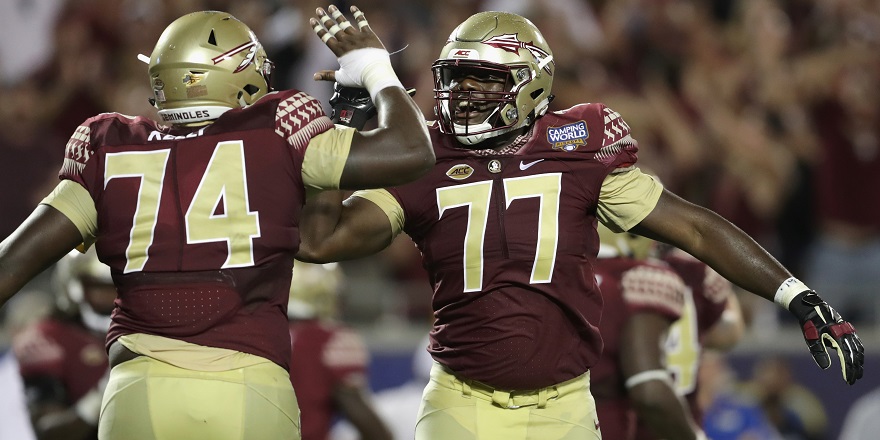
More help for Carson Wentz, only Roderick Johnson is unlikely to boost the offense a ton in 2017. Selecting a left tackle would be a wise long-term strategy for the Eagles, considering Jason Peters' age and Lane Johnson's suspensions. Losing Lane Johnson disrupted Philadelphia's strong start to the season, as rookie Halapoulivaati Vaitai predictably toiled in his stead. A raw yet imposing prospect, the Eagles would represent the perfect situation for Roderick Johnson, allowing him to sit for a year or two. He has all the physical tools to emerge as a starting NFL left tackle and, at just 21, has plenty of time to work out his minor technical deficiencies. — John Breitenbach, @PFF_John
91. Kansas City Chiefs
Nathan Peterman, QB, Pittsburgh
After failing to land a quarterback earlier in the draft, the Chiefs get a QB ready to step right in as a backup — and a potential replacement for Alex Smith. While his arm is limited, Peterman shows good footwork in the pocket and has a quick release. Peterman had the nation’s second-best passer rating when pressured, at 114.7. — Mark Harrington, @PFF_Mark
92. Dallas Cowboys
Future Hall-of-Fame TE Jason Witten recently signed a four-year extension to remain with Dallas through 2021. However, the impressive TE depth of the 2017 class provides the perfect opportunity to select an heir-apparent to the 34-year-old veteran. Butt joins the Cowboys while recovering from a second right ACL tear that occurred during December's Orange Bowl appearance. Learning the nuances of functioning in Dallas' offense directly from Witten will be invaluable, and Butt has already proven himself more than capable of contributing to the passing attack after dropping only seven combined passes during the last three seasons in Ann Arbor. — Wes Huber, @PFF_Wes
93. Green Bay Packers
The Packers finally take a mid-round linebacker with some athleticism. After knocking out cornerback with their first two picks, Green Bay addresses the next biggest need on the defense with PFF's second-highest-graded linebacker from a season ago. — Mike Renner, @PFF_Mike
94. Pittsburgh Steelers
Hansen is a solid route runner with suddenness out of the cut and a good feel for zones in the passing game. Perhaps his greatest strength is making the downfield contested catch. He was sixth in the nation in 20-plus-yard catches last season. — Zac Robinson, @Zac_Robinson5
95. TRADE: New York Jets from Atlanta Falcons
[Trade details: Jets receive Round 3 pick (No. 95 overall) and Round 5 pick (No. 173) for Round 3 pick (No. 107) and Round 5 picks (Nos. 149 and 154 overall).]
After watching safeties Budda Baker and Tedric Thompson get picked, Eddie Jackson became a priority. While he may not contribute immediately on defense, the Jets are in need of a dynamic return man, and Jackson is just that. He brought back two punts for TDs and averaged 22.9 yards per return in 2016 (led all FBS player with at least 10 returns). On top of this, Jackson has great hands, the ability to play both man/zone coverage, and the speed/length to play centerfield in the NFL. He has all the tools to become a starting-caliber free safety. — John Gatta, @PFF_JohnGatta
96. New England Patriots
Vanderdoes has the skills to be a highly-disruptive interior defender versus the pass and the run. We may have yet to see the best of him if his health can continue to improve after recovering from an ACL tear in 2015. In his college career, he has 50 combined stops, and only three missed tackles. — Louie Benjamin, @PFF_Louie
97. Miami Dolphins (compensatory selection)
Dawkins can come into camp competing with Anthony Steen and newly-acquired Ted Larsen for a starting guard spot. Having posted a 98.4 pass-blocking efficiency at left tackle, Dawkins is a versatile piece at 6-foot-5, 330 pounds, that the Dolphins will find a spot for. — Steve Slowik
98. Carolina Panthers (compensatory selection)
Sutton's 2014 season (84.1 PFF overall grade, 51.6 passer rating allowed) was his best at Tennessee, but a strong week at the Senior Bowl in both team and individual sessions showed his ability to return to that form. Sutton worked extensively in the slot and at safety during the Senior Bowl, which and took to those positions quickly even though he worked mostly as an outside corner for the Volunteers. — Ben Stockwell, @PFF_Ben
99. Seattle Seahawks from Philadelphia Eagles via Baltimore Ravens (compensatory selection)
[Trade details: Eagles receive Round 3 pick (No. 90 overall) for Round 3 pick (No. 99 overall) and Round 6 pick (No. 193 overall).]
The Seahawks continue to add to their major need at offensive line with McDermott, a much-needed solid pass protector who also fits Seattle's zone-heavy rushing attack. His 97.4 pass-blocking efficiency mark ranked 28th among all tackles in the nation in 2016. — Harley Sherman, @PFF_Harley
100. TRADE: New England Patriots from Tennessee Titans via Los Angeles Rams (compensatory selection)
[Trade details: Patriots receive Round 3 picks (No. 100 and No. 103) for Round 3 pick (No. 72).]
Jalen Myrick, who clocked a swift 4.28-40-yard-dash time at the combine, is a player whose grade has improved in each season. He was very productive in coverage in 2016, allowing just 45.1 percent of passes thrown into his coverage to be caught while also breaking up nine passes. He will compete for playing time as a nickel corner for the Patriots and can contribute as a kick returner. — Louie Benjamin, @PFF_Louie
101. Denver Broncos (compensatory selection)
The biggest weakness on the Broncos' defense last season was their run defense, particularly up the middle. Adams is a versatile defender who can play all over the interior line and brings a strong run-defense ability to the table, but can also rush the passer. Last year, both his run-defense and pass-rush grades were above 81.0. — Bryson Vesnaver, @PFF_Bryson
102. Baltimore Ravens (from Seattle Seahawks, compensatory selection)
Justin Senior, OT, Mississippi State
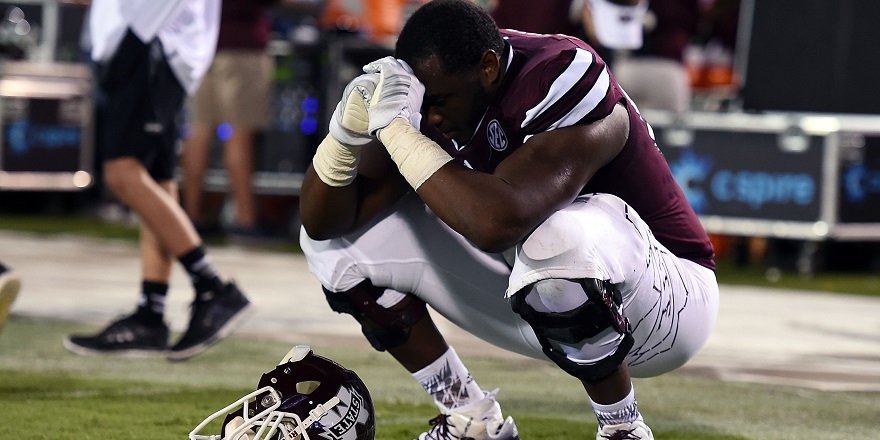
It might seem crazy for the Ravens to go with three offensive linemen in the opening three rounds, but with the way the board has fallen at the end of Round 3, it's a pick that makes sense. A solid fit in a zone scheme, Senior has some work to do to improve his pass protection to be at the NFL level, allowing three sacks, two hits, and 15 hurries in 2016. He would be the Ravens' top backup at tackle, replacing the struggling James Hurst. — Gordon McGuinness, @PFF_Gordon
103. TRADE: New England Patriots from New Orleans Saints via New England Patriots (compensatory selection)
[Trade details: Patriots receive pick No. 32 overall and Round 3 pick (No. 103 overall), Saints receive CB Malcolm Butler and Round 6 pick (No. 199 overall)]
[Trade details: Patriots receive pick No. 23 overall, Titans receive pick No. 32 overall and Round 3 pick (No. 103 overall)]
Evans is a tremendous athlete. As a true coverage linebacker, his incredible measurables show up on film. He allowed a QB rating of just 64.3 in 2016 while intercepting four passes and breaking up five. — Louie Benjamin, @PFF_Louie
104. Kansas City Chiefs (compensatory selection)
While not having top-end speed, Smith-Schuster is a physical receiver who is hard to bring down at times, and shows the ability to go and get 50/50 jump balls. After recording nine drops in 2015, he lowered that number to four last season. — Mark Harrington, @PFF_Mark
105. Pittsburgh Steelers (compensatory selection)
Adam Shaheen, TE, Ashland
Shaheen's unique athleticism for his size gives the Steelers the complete TE they need. He is a physical player with with ability to be a solid inline run blocker, as well as stretch the seams in the passing game. — Zac Robinson, @Zac_Robinson5
106. Seattle Seahawks (compensatory selection)
A versatile pass-rusher who can line up across the formation, Johnson can play at 1-tech on run downs before moving to 3-tech on passing downs. Johnson ranked sixth among defensive tackles in 2016 with 43 total QB pressures and should serve as an upgrade over Ahtyba Rubin and Jarran Reed. — Harley Sherman, @PFF_Harley
107. TRADE: Atlanta Falcons from New York Jets (compensatory selection)
[Trade details: Jets receive Round 3 pick (No. 95 overall) and Round 5 pick (No. 173) for Round 3 pick (No. 107) and Round 5 picks (Nos. 149 and 154 overall).]
Mack Hollins, WR, North Carolina
The Falcons lost deep threat Aldrick Robinson, but Hollins should be good to fill the role he played while contributing on special teams. — Khaled Elsayed, @PFF_Khaled

108. Cleveland Browns
Howard Wilson, CB, Houston
The second CB the Browns take in this loaded draft class is a prospect with solid measurables and impressive coverage numbers. He allowed a passer rating of just 48.3 in his career, notching nine interceptions and 10 passes breakups. Wilson might struggle with the transition to the NFL initially, but has talent and athleticism to develop. — John Kosko, @PFF_JohnKosko
109. San Francisco 49ers
Tanoh Kpassagnon, Edge, Villanova
A physical freak at 6-foot-7 and 289 pounds, Kpassagnon got the attention of teams in the NFL with a big showing at the Senior Bowl. After impressing during one-on-one drills, he racked up a sack, two hits, and a hurry on 18 pass-rushing attempts during the game. — Gordon McGuinness, @PFF_Gordon
110. Jacksonville Jaguars
The Jaguars are in need of a potential future starter at left tackle, and are lucky to snag Troy’s Antonio Garcia here in the fourth round. Garcia’s pass-protection numbers in 2016 were very impressive, as he didn’t allow a sack and only one QB hit and six pressures on his 506 pass-protection snaps. — Jordan Plocher, @PFF_Jordan
111. Chicago Bears
After having missed out on a more complete tight end in George Kittle with the No. 67 pick, the Bears turn to Hollister instead. Zach Miller is coming off a fairly serious foot injury and turns age 33 this season. Hollister may not be much of an in-line tight due to his lack of strength as a blocker, but he is athletic and a good enough route runner to attack a defense at all three levels. He caught seven of 11 deep targets for 189 yard and three touchdowns in 2016. — Matt Claassen, @PFF_Matt
112. Los Angeles Rams
Isidora was one of the highest-graded pass-protecting guards in the country last year, and also ranked as one of the top guards in the run game during the 2014 season. Isidora will join new left tackle Andrew Whitworth as the Rams rebuild an offensive line that graded near the bottom of the league in both team pass-blocking and run-blocking in 2016. — Kiernan Hogan, @PFF_Kiernan
113. Los Angeles Chargers
Isaiah Ford, WR, Virginia Tech
The Chargers have a number of useful receivers, but have also had injury problems at the position, so it doesn’t hurt to add another talented target for QB Philip Rivers. Ford earned PFF receiving grades of 81.3 and 82.5 in 2016 and 2015, respectively. — Kevin Connaghan, @PFF_Kev
114. Washington Redskins from New York Jets
Damontae Kazee, CB, San Diego State
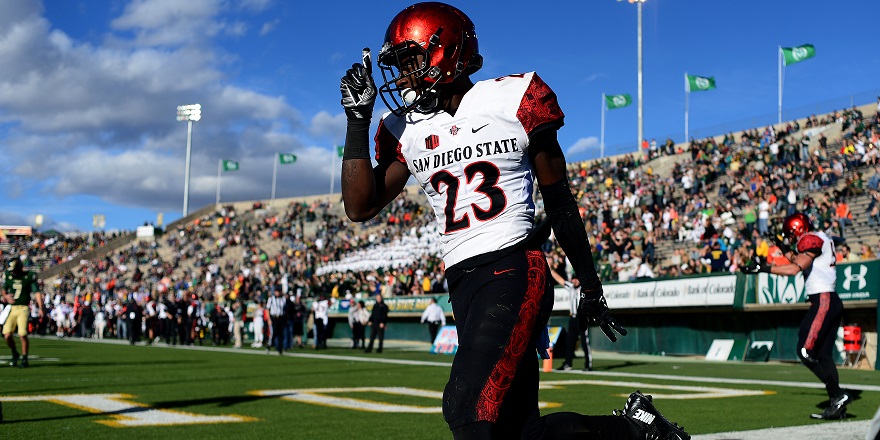
Kazee is better off the ball and lacks the athleticism to hold up one-on-one deep. He makes very quick reads on routes, is a solid tackler, and is very effective in coverage on shorter routes. Ranking among the top 10 CBs in tackling efficiency, he allowed just 2.75 yards after the catch per reception. He can play either inside or outside, depending more on matchup than position, but he should strengthen a Washington cornerback group that struggled in 2016 outside of Josh Norman. — Trevor Lynch, @PFF_Lynch
115. Carolina Panthers
Three excellent seasons for the Cornhuskers (80.0 overall grade or better every year) saw Gerry rack up 84 stops (third most in this class since 2014) and 24 pass breakups and interceptions (tied most in this class). Gerry could compete for playing time earlier than you might expect for a fourth-round pick, and his ability to play both the run and pass fits well with how the Panthers deploy their safeties. — Ben Stockwell, @PFF_Ben
116. Cincinnati Bengals
Raekwon McMillan, LB, Ohio State
The former Ohio State standout didn't show the great coverage ability that his combine numbers would suggest, but he was excellent against the run, and the Bengals rotate their LBs enough to justify a fourth-round pick on a coverage liability. His 85.4 run-defense grade was one of the best in the nation while posting an above-average 11.1 run-stop percentage. — John Kosko, @PFF_JohnKosko
117. Chicago Bears from Buffalo Bills
Stewart works very well against zone defenses and can find and settle in the holes between zones. He has room for improvement as a route runner against tight coverage, where he can't separate as easily, but is one of the best outside receivers after the catch. His 10.7 yards after catch average was the second-highest mark in the nation among Power-5 wide receivers with at least 20 receptions. — Matt Claassen, @PFF_Matt
118. Philadelphia Eagles
Depth is a necessity for a defensive front that requires all-out aggression on every snap. Rotation significantly weakened the unit within games at times in 2016. Price is an older prospect with injury concerns, but his production ranks him toward the top of the class. Although shorter than ideal, Price's explosion and arc-running refinement make him excellent value in the middle rounds. He joins as the team's fourth-best edge rusher. — John Breitenbach, @PFF_John
119. Arizona Cardinals
Webb is a big prospect at 6-foot-5 and 230 pounds with a very strong arm, and fits what the Cardinals want to do on offense. Coaches rave about his work ethic, and he should be able to pick up the Cardinals' offense and be ready to go when Carson Palmer decides to hang it up. Webb will need to work on his deep accuracy while backing up Palmer, as he was only accurate on 38.6 percent of his deep passes in 2016. — Jordan Plocher, @PFF_Jordan
120. Minnesota Vikings
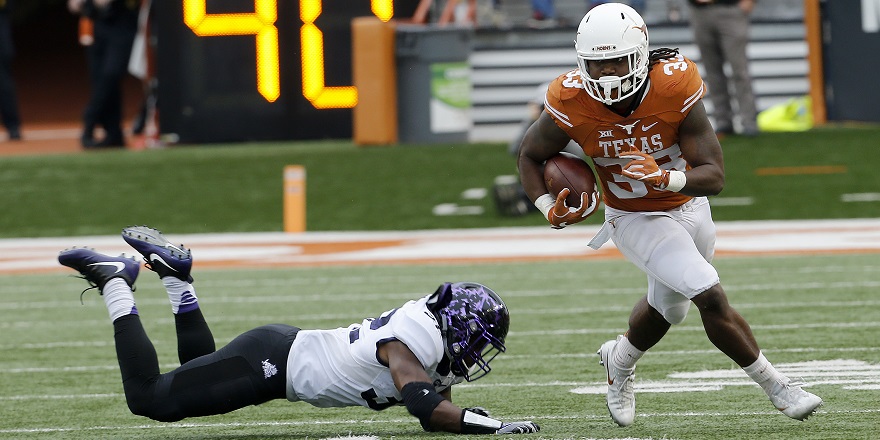
Signing Latavius Murray is a solid stopgap at the running back position for Minnesota, but Murray is a limited player who may never provide the kind of impact the team wants at the position, having been spoiled with Adrian Peterson for so many years. D'Onta Foreman won't replace Peterson, either, but he may provide a bigger impact than Murray long-term. — Sam Monson, @PFF_Sam
121. Indianapolis Colts
The Colts need an influx of youth at running back, and Wiliams brings a style similar to current Colt RB, Frank Gore. Williams forced 55 missed tackles on only 235 attempts last season and he's a good fit for the downhill running style preferred by Indianapolis. — Steve Palazzolo, @PFF_Steve
122. Baltimore Ravens
Joe Flacco isn't so old that he needs a replacement now, but his struggles as he attempted to comeback from injury last season were evident. With that in mind, the Ravens start to look to the future and grab a player who could have been a higher draft pick if he had continued to develop last season. The flashes have been there for Kaaya, and he excelled when he had a clean pocket, with an NFL passer rating of 113.0 on such plays. — Gordon McGuinness, @PFF_Gordon
123. Washington Redskins
A tough, physical player with a high motor. Glasgow anchors very well, stabilizing the gap against double-teams, but struggles some moving laterally on outside runs. He provided a balanced attack in his senior year at Michigan with 37 total QB pressures and 24 stops. Between Glasgow and Tomlinson, the Washington defense has dramatically improved its front, especially stopping the run. — Trevor Lynch, @PFF_Lynch
124. Tennessee Titans
Hill brings immediate viability and versatility, as he is capable of pressing from the slot as well as defending the run. He projects long-term as a potential starting free safety, making him excellent value for the Titans at this stage in the draft. In 2016 he gave up just 22 receptions on 40 throws into his primary coverage. — Josh Liskiewitz, @PFF_Josh
125. Tampa Bay Buccaneers
WR depth is considered here. However, there are plenty of similar WRs still on the board, so the focus turns to rotational help in the secondary. Jones adds size, elite athleticism, and the ability to cover bigger TEs. He has experience at both safety positions, but the Bucs will need to temper his overly-aggressive nature. His 6.8 run-stop percentage ranks him seventh among safeties, but he ranks 61st in tackling efficiency, usually because he over-pursues. — Bill Douglas, @PFF_Bill
126. Denver Broncos

After going after an interior defender a round earlier, we're double-dipping because that's how big of a weakness this was for the Broncos last year. Ogunjobi can play nose tackle for the Broncos, and is a force against the run. His run-defense grade of 90.4 was fourth-highest in the country last season. — Bryson Vesnaver, @PFF_Bryson
127. Detroit Lions
Reynolds gives the Lions the true deep threat they currently lack, as he combines excellent long speed and ball skills. He scored at least one touchdown in 12 of 14 games played this season, including the East-West Shrine game. — Josh Liskiewitz, @PFF_Josh
128. Minnesota Vikings from Miami Dolphins
Fabian Moreau, CB, UCLA
The Vikings don't have a big cornerback need, though it may prove bigger than they believe depending on the play of their young guys in 2017. That said, Moreau proves too much value to pass up here. He has fallen due to injury, but Minnesota likely won't need him near the field in year one, anyway. — Sam Monson, @PFF_Sam
129. TRADE: Cincinnati Bengals from Oakland Raiders
[Trade details: Raiders receive Round 3 pick (No. 73 overall) for Round 3 pick (No. 88 overall) and Round 4 pick (No. 129 overall)]
In a deep pass-rushing draft class, the Bengals double-dip into the talented edge pool. Basham was impressive in Senior Bowl practices, posted excellent numbers at the combine, and has the length Cincinnati covets at defensive end. Had recorded 10th-best pass-rushing productivity mark on throws under 2.5 seconds. — John Kosko, @PFF_JohnKosko
130. TRADE: Washington Redskins from Houston Texans
[Trade details: Redskins receive Round 4 pick (No. 130 overall) for Round 5 pick (No. 153), Round 6 pick (No. 208), and Round 7 pick (No. 234)]
Nico Siragusa, G, San Diego State
The Redskins had an excellent offensive line last season with the exception coming from its LG, where Shawn Lauvao allowed the second-most pressures among all NFL guards in 2016, with 32. Nico Siragusa allowed two pressures last year, and only 14 in his entire college career. The level of competition will be raised, but regardless, his production is impressive, ranking second in the class in both pass-blocking efficiency and run-block success percentage. — Trevor Lynch, @PFF_Lynch
New England Patriots from Seattle Seahawks
Pick forfeited.
131. Kansas City Chiefs
Samson Ebukam, Edge, Eastern Washington
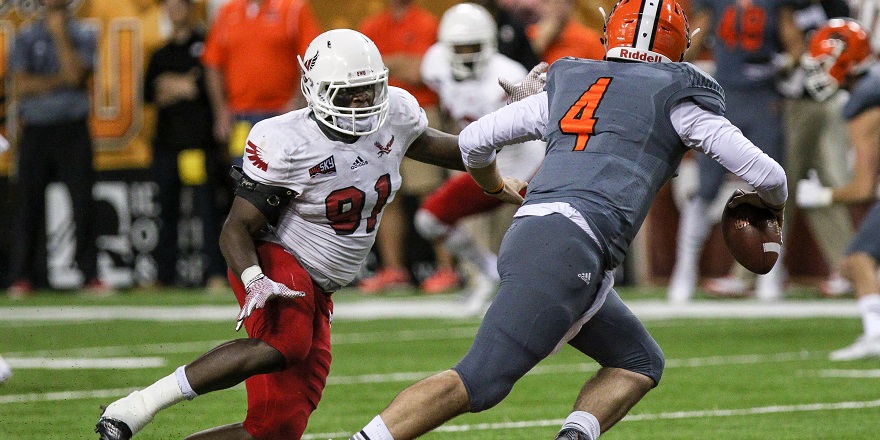
Ebukam was a dominant pass-rusher at the FCS level who showed explosive athleticism. He finished with 11 sacks, 10 hits, and 42 hurries on 398 pass-rushing snaps in 2016, but also missed nine tackles. He lined up on the right side of the line on 48 percent of his snaps and on the left side 43 percent. — Mark Harrington, @PFF_Mark
132. Dallas Cowboys
DeAngelo Brown, DI, Louisville
Despite being overlooked amongst the 300 individuals invited to the NFL Combine, Dallas is certainly looking forward to add the run-plugging interior lineman to the roster. Brown excelled when bull-rushing offensive linemen and showcased the ability to absolutely rag-doll blockers. With PFF overall grades in excess of 80.0 in each of the last three seasons, Brown will immediately compete as a base-package specialist with the Cowboys. — Wes Huber, @PFF_Wes
133. Green Bay Packers
Odds are that last year's Packers-Cowboys playoff thriller was a preview of a brewing NFC rivalry. They'll likely meet up again in the postseason soon, and Green Bay cannot cede yards against heavy formations like they did last year. Tu'ikolovatu is an ox in the middle and allows Kenny Clark to kick out to end, making that front considerably more formidable against the run. — Mike Renner, @PFF_Mike
134. Pittsburgh Steelers
Hometown pick: Conner's tough running style and balance through contact compliment Le'Veon Bell well. Conner led the nation in 2014 with 88 broken tackles. — Zac Robinson, @Zac_Robinson5
135. Atlanta Falcons
Johnson can come in and compete straight away at right guard. He has the athletic tools to succeed in a primarily zone-based scheme and has proven to be an extremely reliable pass protector in college, allowing just 15 combined sacks, hits, and hurries over three seasons. — Khaled Elsayed, @PFF_Khaled
136. Indianapolis Colts from New England Patriots
Anderson had incredible production at Alabama, finishing with 22 sacks, 27 QB hits, and 80 hurries over the last three years. He also provided stout run defense, and while he may have athletic limitations, Anderson is worth a look to see if he can carry that production to the next level, and the Colts can't take too many shots at finding pass-rushers. — Steve Palazzolo, @PFF_Steve
137. Cincinnati Bengals (compensatory selection)
Jeremy McNichols, RB, Boise State
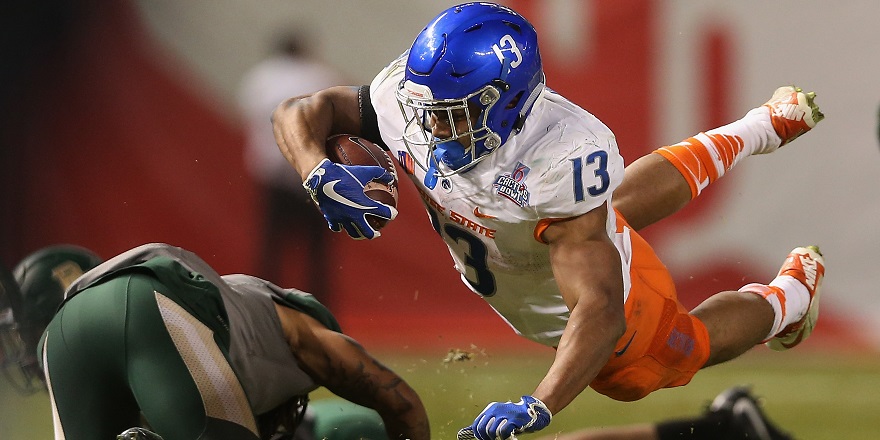
A back capable of playing all three downs in the NFL, the Bengals take the talented McNichols. The former Boise State star posted good numbers at the combine and pairs that with outstanding production as a runner, as well as some of the best numbers as a receiver. He dropped just two of 107 catchable passes in college. — John Kosko, @PFF_JohnKosko
138. Philadelphia Eagles from Cleveland Browns (compensatory selection)
The Eagles go back-to-back on the defensive line in Round 4, adding depth to the interior on this occasion. Watkins is unlikely to collapse the pocket consistently, but he can make a significant impact using his power and length against the run. Philadelphia is thin on the interior, and Watkins has the talent to make an instant contribution as a role player in his first pro season. — John Breitenbach, @PFF_John
139. New York Giants (compensatory selection)
Banner gives the Giants competition at offensive tackle. He only allowed pressures in four of 11 games last year, and the Giants' run game already plays to Banner's strengths. — Nathan Jahnke, @PFF_NateJahkne
140. Los Angeles Rams (compensatory selection)
While Brown is inexperienced (just one full season as a starter after missing all of 2015 due to injury), the athleticism, route running, and blocking ability that he put on tape last season makes him an excellent value at this point in the draft. Brown may be the most physical blocker of any receiver in this class, which should allow him to earn immediate playing time on special teams, with the potential to develop into a starting X receiver. — Kiernan Hogan, @PFF_Kiernan
141. Houston Texans from Cleveland Browns (compensatory selection)
Brian Cushing is on the decline, and Bernardrick McKinney ranked last among linebackers with seven touchdowns allowed in coverage last season. Adding a young, coverage linebacker is an underrated need for the Texans, and UCLA’s Jayon Brown will be a great fit in that role. Brown’s 87.6 PFF coverage grade ranked fourth in the nation last season, and opposing QBs had a rating of just 50.4 when targeting him. — Vinnie Ronca, @PFF_Vinnie
142. San Francisco 49ers (compensatory selection)
This is a value selection by the 49ers. You can never have too many pass-rushers, and Biegel is someone who could really develop in San Francisco. Ultimately, he may transition to an off-ball linebacker role in the NFL, but his 99 total QB pressures on 493 pass-rushing attempts make him an intriguing option as a situational pass-rusher early in his career. — Gordon McGuinness, @PFF_Gordon
143. Indianapolis Colts (compensatory selection)
Kenneth Olugbode, LB, Colorado
Another potential starter on the defensive side of the ball, Olugbode is strong in coverage, with grades of 81.4 and 83.0 in each of the last two years. He improved greatly against the run in 2016, finishing at 86.6 as he fluidly moves to the ball. — Steve Palazzolo, @PFF_Steve

144. Cleveland Browns
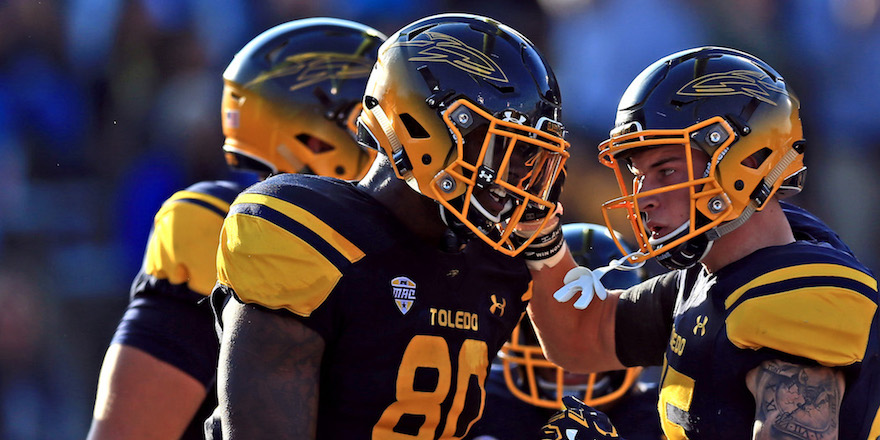
With Gary Barnidge declining in production, the Browns look to pick up a good blocking tight end with sure hands and body control to be a weapon in the receiving game. With just three drops in 2016 and a massive 16 TDs, Roberts has the size and possesses the effort to be a serviceable TE in the NFL. — John Kosko, @PFF_JohnKosko
145. San Francisco 49ers
Channing Stribling, CB, Michigan
Stribling was incredibly productive in 2016, with opposing quarterbacks having an NFL passer rating of just 22.7 when throwing at him, the second-lowest mark in the country (minimum 40 targets). He might not be the fastest cornerback around, but he is physical, and could develop into a quality starter in the NFL. — Gordon McGuinness, @PFF_Gordon
146. Chicago Bears
Fred Zerblis, G, Colorado State
Zerblis has been a highly-effective guard for Colorado State, showing versatility to block in both zone and gap run schemes. He did not allow a sack in either of the past two seasons, and just 10 QB pressures total on 831 snaps in pass protection over that time. Level of competition and athletic ability are concerns, but he gives the Bears some needed depth along the offensive line. — Matt Claassen, @PFF_Matt
147. Jacksonville Jaguars
Marlon Mack, RB, South Florida
Marlon Mack will bring a big-play element to the Jaguars’ backfield. Last season, 52.3 percent of Mack’s rushing yards came on his 15 runs of 15-plus yards; that breakaway percentage ranked fifth among running backs in the draft class with at least 90 carries. — Jordan Plocher, @PFF_Jordan
148. Los Angeles Rams
The Rams add an athletic tight end with consistent hands and the ability to produce from the slot. Sprinkle looks the part of an inline tight end, but needs to improve his blocking ability to earn playing time in that role at the NFL level. Sprinkle should be able to contribute immediately as a red-zone threat at a thin position for the Rams. — Kiernan Hogan,@PFF_Kiernan
149. TRADE: Atlanta Falcons from New York Jets
[Trade details: Jets receive Round 3 pick (No. 95 overall) and Round 5 pick (No. 173) for Round 3 pick (No. 107) and Round 5 picks (Nos. 149 and 154 overall).]
Anthony Walker, LB, Northwestern
Walker was very productive in college, where he earned the seventh-highest production grade of all linebackers. His initial contribution will mainly be on special teams. — Khaled Elsayed, @PFF_Khaled
150. Los Angeles Chargers
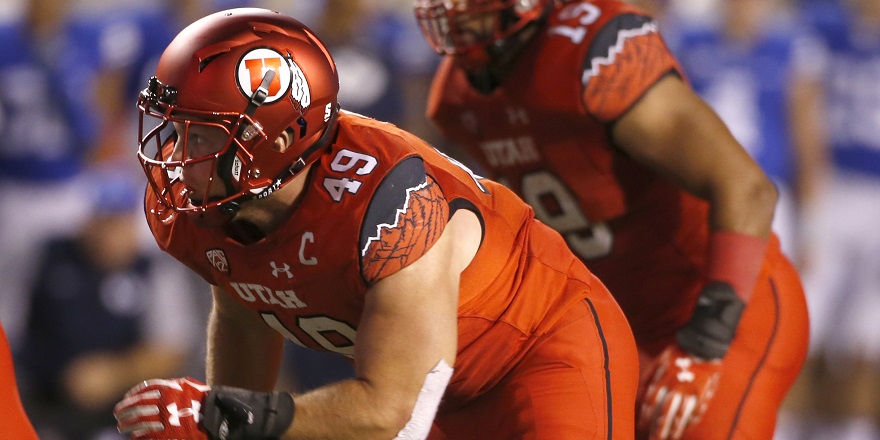
The Chargers add to their pass-rush rotation with edge rusher Hunter Dimick. Dimick enjoyed a hugely-productive senior season for the Utes, recording 17 sacks and 83 total QB pressures. — Kevin Connaghan,@PFF_Kev
151. Carolina Panthers
The Panthers have the need for speed in their wide receiver corps, and Josh Malone adds that immediately. Malone converted 10 of his 13 deep receptions in 2016 into touchdowns; only three WRs recorded more deep touchdowns than Malone in all of college football this past season. — Ben Stockwell, @PFF_Ben
152. Cincinnati Bengals
With the Bengals' offensive line woes needing addressed, they choose the top OT prospect on the board in Auburn's Robert Leff. A one-year starter, Leff graded well, allowing just two sacks and one hit while posting a pass-blocking efficiency of 97.2 on five-step dropbacks. He'll need development, but has a good understanding of angles and hand usage to become a good tackle in the NFL. — John Kosko, @PFF_JohnKosko
153. Houston Texans from Washington Redskins via New Orleans Saints
With Vince Wilfork's likely retirement, the Texans are in need of some depth along their defensive line. Elijah Qualls is a big-bodied, versatile defender who graded almost equally well in both run defense (84.6) and as a pass-rusher (81.1) in 2016. His ability to line up at multiple positions along the line should help him be an early contributor for the Texans next season. — Vinnie Ronca, @PFF_Vinnie
154. TRADE: Atlanta Falcons from New York Jets via Philadelphia Eagles
[Trade details: Eagles receive Round 2 pick (No. 39 overall) and Round 7 pick (No. 223 overall), Jets receive Round 2 pick (No. 43 overall) and Round 5 pick (No. 154 overall)]
[Trade details: Falcons receive Round 3 pick (No. 107) and Round 5 picks (Nos. 149 and 154 overall) for Round 3 pick (No. 95 overall) and Round 5 pick (No. 173) ]
With a need for a swing tackle, the Falcons can take a chance on the athletic upside of Smith, who allowed just 22 total QB pressures in 2016. — Khaled Elsayed, @PFF_Khaled
155. Buffalo Bills
Maye doesn't profile as a single-high safety with the range to man centerfield, which is a player the Bills are still in search of, but at this stage in the draft, those prospects are off the board. That said, Buffalo goes with one of the better box safety prospects in the entire class to add another dynamic piece to the secondary. Maye enters the league with an NFL body in terms of size and strength. He ranked first among FBS safeties with at least 300 snaps in tackling efficiency (he missed just one tackle all season) and should be competent in coverage in two-high looks while being able to step down into the box during single-high looks. — Billy Moy, @PFF_Billy
156. Arizona Cardinals
Donnel Pumphrey, RB, San Diego State

Bruce Arians has stated that Andre Ellington will be moving to wide receiver in 2017. Pumphrey can play the former “Ellington” role in the backfield as a change-of-pace running back with the ability to be a mismatch player in the passing game. Pumphrey forced 208 missed tackles as a runner over the past three seasons. — Jordan Plocher, @PFF_Jordan
157. Indianapolis Colts
Nazair Jones, DI, North Carolina
Jones is built like a classic 3-4 defensive end who is excellent against the run. His pass rushing leveled off in college, but he can at least be an early-down contributor with hopes of building on the pass-rushing flashes he showed early in his career at North Carolina. — Steve Palazzolo, @PFF_Steve
158. Baltimore Ravens
The Ravens have done an excellent job adding to their secondary this offseason, so it's no longer a huge need. That being said, Tocho is great value here, and the NC State defender allowed just 10 receptions over the final seven games of the season. A developmental project, he would compete to be the Ravens' fourth cornerback as a rookie and contribute on special teams. — Gordon McGuinness, @PFF_Gordon
159. Minnesota Vikings
Jalen Robinette, WR, Air Force
Minnesota's receiving corps is still unproven outside of Stefon Diggs, but Jalen Robinette provides an interesting insurance option to last year's top rookie, Laquon Treadwell. Robinette caught passes for 26.2 yards per carry in 2016, gaining more than 7 yards per reception after the catch on average. — Sam Monson, @PFF_Sam
160. San Francisco 49ers from Washington Redskins
Daniel Brunskill, OT, San Diego State
Brunskill played both tackle and tight end in his college career, and it shows with how well he moves in space. He is a developmental prospect, but also had the eighth-highest percentage of positively-graded plays among draft-eligible tackles in 2016, so he could eventually become a starter. — Gordon McGuinness, @PFF_Gordon
161. Tampa Bay Buccaneers
Zamora falls due to some off-field issues, but at 6-foot-3, 224 pounds, with 4.5 speed, his physical attributes are too good to pass on in the fifth round. Coming from Baylor's system, he'll need some time to reach his full potential, but he should contribute right away given the talent that surrounds him. He will need to improve his hands, as he dropped 10 of 73 catchable passes in 2016. — Bill Douglas, @PFF_Bill
162. New England Patriots from Denver Broncos

Bower is more potential than production , as 48.5 percent of his pressure production came on clean up or unblocked plays. However, at this point in the draft, he has too much athletic upside to pass up. If anyone can find a spot in the defense for him to succeed, it's Bill Belichick. — Louie Benjamin, @PFF_Louie
163. TRADE: Cincinnati Bengals from Tennessee Titans
[Trade details: Bengals receive Round 3 picks (Nos. 83 and 87 overall) and Round 5 pick (No. 163 overall) for Round 2 pick (No. 41 overall)]
Carr was a one-year wonder for Northwestern, but possess elite lateral agility and a natural feel for coverages. His 90 receptions and 1,247 yards out of the slot were both among the top three in the draft class, and he should be able to contribute there for the Bengals. — John Kosko, @PFF_JohnKosko
164. TRADE: New Orleans Saints from Detroit Lions
[Trade details: Saints receive Round 5 picks (Nos. 164 and 168 overall) for Round 3 pick (No. 76 overall) and Round 6 pick (No. 195 overall)]
Najee Murray, CB, Kent State
Even though the Saints have already acquired Malcolm Butler from the Patriots in this mock draft, they still need cornerback depth, and they get it with Kent State's Najee Murray. The Steubenville native allowed a completion percentage of just 41.8 percent over the past two seasons and did not surrender a single touchdown in coverage in 2016, demonstrating good ball skills and recording nine pass breakups and two interceptions. In addition, Murray allowed a passer rating of just 38.4 into his coverage in 2016. —Zoltán Buday, @PFF_Zoltan
165. Miami Dolphins
Starting center Mike Pouncey has battled injuries the past few seasons, so by selecting Toth, who had only given up four sacks in his Kentucky career, Miami builds depth along the offensive line while also potentially grooming their center for the future. — Steve Slowik
166. New York Giants
Cannon gives the Giants a potential deep threat that New York can develop. Over the last three years, he recorded 1,664 receiving yards and 19 deep touchdowns; both second-best in the FBS over that time. — Nathan Jahnke, @PFF_NateJahkne
167. Oakland Raiders
Linebacker certainly qualifies as a “need” for the Raiders in this draft, but the way the board fell, the value never quite lined up with when they were selecting. I likely would have taken Anzalone had I stayed put in the fourth, so getting him this far down is fantastic value. — Mike Renner, @PFF_Mike
168. TRADE New Orleans Saints from Detroit Lions via Houston Texans
[Trade details: Saints receive Round 5 picks (Nos. 164 and 168 overall) for Round 3 pick (No. 76 overall) and Round 6 pick (No. 195 overall)]
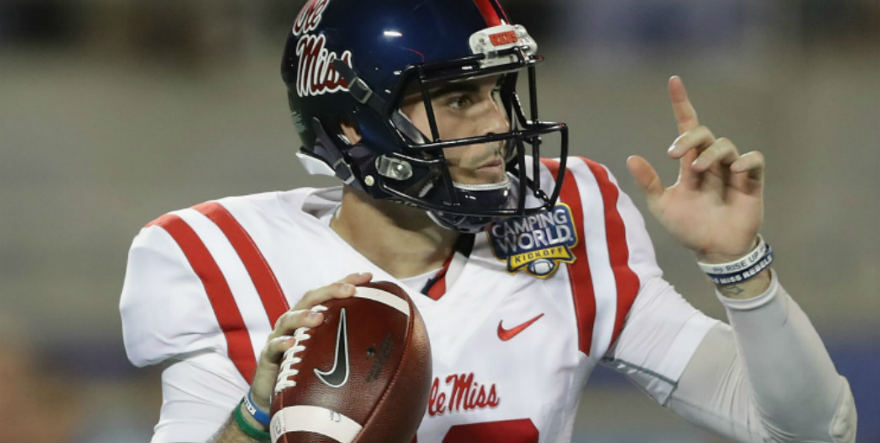
Drew Brees has reached the stage of his career where the Saints must be looking for his successor, and while Kelly is not ready to start in the NFL (and also has off-field issues), sitting and learning behind Brees can certainly help him. Kelly's adjusted completion percentage of 43.6 on passes traveling at least 20 yards in the air was the 21st-best in college football last season. —Zoltán Buday, @PFF_Zoltan
169. Kansas City Chiefs
Over the past three seasons, Gallman forced 153 missed tackles, fifth-most in the 2017 draft class, breaking many of those from attempts by safeties and cornerbacks. He has enough burst to pull off big runs, but struggles to get through tight holes on interior runs. — Mark Harrington, @PFF_Mark
170. Buffalo Bills from Dallas Cowboys
While Darboh doesn't do any one thing spectacularly, he does many things well. He ran a diverse route-tree at Michigan that should help him adapt to the next level, is capable of making contested catches, and can eat a big hit over the middle. On top of that, Darboh is one of the better run-blocking receiver prospects in the draft — something that Buffalo valued Robert Woods for — finishing 2016 with the ninth best run blocking grade among all NCAA receivers. — Billy Moy, @PFF_Billy
171. Green Bay Packers
Elijah Hood, RB, North Carolina
With Lacy gone, the Packers lost a considerable amount of power from their running back stable. Hood replaces that. Injuries slowed him as a junior, but Hood's sophomore tape is that of a mid-round selection. — Mike Renner, @PFF_Mike
172. Pittsburgh Steelers
Godchaux brings some versatility as an interior pass-rusher in nickel and dime situations. He recorded 17 knockdowns and 32 total pressures in 2016. — Zac Robinson, @Zac_Robinson5
173. TRADE: New York Jets from Atlanta Falcons
[Trade details: Jets receive Round 3 pick (No. 95 overall) and Round 5 pick (No. 173) for Round 3 pick (No. 107) and Round 5 picks (Nos. 149 and 154 overall).]
Garrett Sickels, Edge, Penn State
A New Jersey native, Sickels comes back home with this selection. He had a productive junior season, generating 10 sacks, 12 QB hits, and 34 QB pressures. Sickels’ lack of a quick first step projects him to better be utilized as a 3-4 OLB. This way he can use his hands and smarts to set up/break down his opposing blocker. — John Gatta, @PFF_JohnGatta
174. Cleveland Browns from New England Patriots
Ryan Switzer, WR, North Carolina
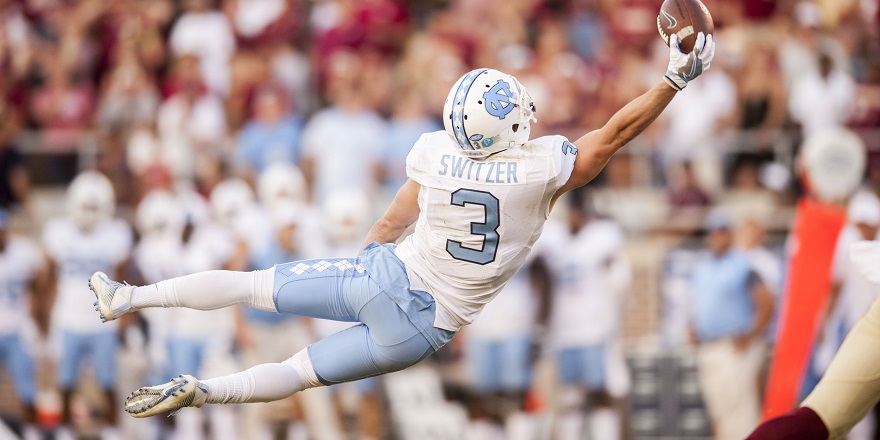
The Browns drafted four WRs in 2016, but take one here, as Switzer can contribute immediately as a returner and a good weapon out of the slot. With seven career special teams returns and excellent lateral agility, Switzer also shows the smarts to read defenses and adjust routes accordingly. — John Kosko, @PFF_JohnKosko
175. Cincinnati Bengals (compensatory selection)
Trent Taylor, WR, Louisiana Tech
The Bengals double dip at the slot WR in the fifth round, as Taylor's value was too good to pass up here with a fourth-round grade on the small but quick Louisiana Tech prospect. 131 of his 137 receptions came from the slot, and he possesses excellent hands, even through contact. — John Kosko, @PFF_JohnKosko
176. Denver Broncos (compensatory selection)
Tanner Vallejo, LB, Boise State
Vallejo has high-level athleticism and instincts along with coverage skills. Injuries have slowed him down in recent years, but in 2014, he was the second-highest graded LB in college, at 93.1 overall. — Bryson Vesnaver, @PFF_Bryson
177. Miami Dolphins (compensatory selection)
Omarius Bryant, DI, Western Kentucky
Bryant recorded 46 quarterback hurries last year for the Hilltoppers, and he'll have the opportunity to work himself into a rotation behind Ndamukong Suh and Jordan Phillips. — Steve Slowik
178. Arizona Cardinals (compensatory selection)
Damien Mama didn’t allow a sack in 2016 and only gave up one QB hit and seven hurries on his 449 pass-blocking snaps last season. Mama is also a people-mover as a run blocker. He should be able to come in and contend for the starting spot at right guard. — Jordan Plocher, @PFF_Jordan
179. Kansas City Chiefs (compensatory selection)
With the Chiefs' offensive line set, it gives Koloamatangi time to develop, but with high upside just on his physical tools alone. He allowed just one sack and six QB hurries while seeing snaps at RG (57 percent), C (37 percent) and at T (6 percent). — Mark Harrington, @PFF_Mark
180. Cleveland Browns (compensatory selection)
Jordan Sterns, S, Oklahoma State

An aggressive, run-defending safety that has improved in coverage each year of his career, Sterns brings plenty of experience to work with. He surrendered a passer rating of just 57.3 in coverage, while allowing the sixth best-yards-per-coverage-snap mark, at 0.34. — John Kosko, @PFF_JohnKosko
181. Green Bay Packers (compensatory selection)
The Packers would love to leave this draft with at least one edge rusher, and snagging Daeshon Hall in the fifth is great value. His college career was plagued by timid play, but he has the size and athleticism to be an even more effective player at the next level. — Mike Renner, @PFF_Mike
182. New England Patriots (compensatory selection)
Perine is the No. 100 overall ranked player on the PFF big board, so getting him here at pick No. 182 was a great value that also filled a need. Perine can fill the big back role on the roster, which is vacant as of this moment. In his career at Oklahoma, Perine forced 157 missed tackles and averaged 3.5 yards after contact per carry. — Louie Benjamin, @PFF_Louie
183. Miami Dolphins (compensatory selection)
Dupre brings size and athleticism to an already explosive Dolphins receiving corps. He can play multiple receiver spots and has been sure-handed throughout his college career, dropping only nine passes on 176 targets. — Steve Slowik

184. Cleveland Browns
The Browns covet athleticism, and Gedeon has that, as he posted solid all-around numbers at the combine. A good run defender at Michigan, Gedeon was suspect in coverage, as he allowed 20 of 26 targets in his coverage area to be caught. He is a two-down linebacker that could play a few snaps as a rookie will contribute on special teams. — John Kosko, @PFF_JohnKosko
185. Baltimore Ravens from San Francisco 49ers
With the board thinning, I think adding a powerful runner like Hill here makes a lot of sense. At 6-feet-1, he runs with a lot of power and can produce big gains, with 30 runs of 15-plus yards in 2016, the third-most in this draft class. — Gordon McGuinness, @PFF_Gordon
186. Jacksonville Jaguars
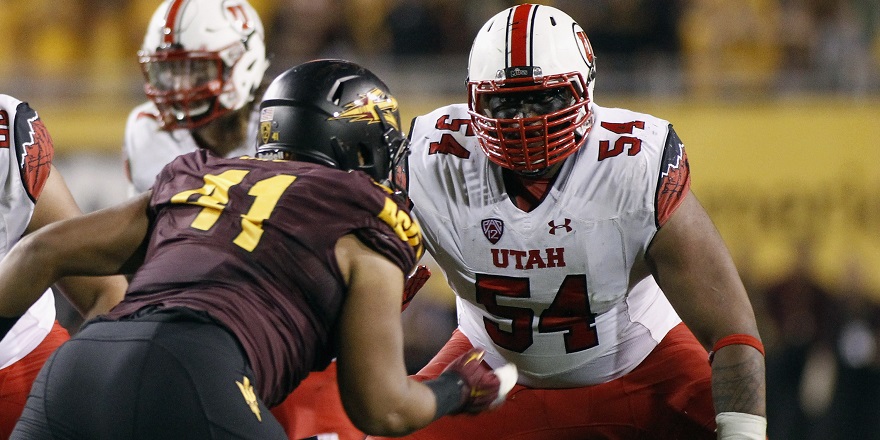
Asiata is at his best pushing people around as a run blocker. He can also set the bottom of the pocket as a pass blocker, as he didn’t surrender a pressure to a bull-rush in 2016. Asiata will add depth to the interior of the Jaguars’ offensive line. — Jordan Plocher, @PFF_Jordan
187. Cleveland Browns from Houston Texans via Chicago Bears
Ifeadi Odenigbo, Edge, Northwestern
Another athletic defensive player, the Browns select a productive edge rusher out of Northwestern. Odenigbo racked up 10 sacks and 10 hits in 2016 while grading well as a pass-rusher each of the past three seasons. While he didn't play on special teams at Northwestern, he has the talent and skills to do so in order to make the team early in his career. — John Kosko, @PFF_JohnKosko
188. Los Angeles Rams
Tyler Orlosky, C, West Virginia
Orlosky allowed just four hurries and no sacks last season, and is one of the most consistent pass protectors among draft-eligible centers. The Rams add a reliable lineman to compete with veteran John Sullivan as they continue to revamp their offensive line. — Kiernan Hogan,@PFF_Kiernan
189. Los Angeles Chargers
The Chargers found Antonio Gates' successor when they drafted Hunter Henry last year, but there is room for another TE to develop behind that pair as the future No 2. Pharaoh Brown may not have been 100 percent fit in 2016, but he was still a reliable target for Oregon’s QBs, who had a 139.7 passer rating when throwing to him, the third-best mark in this TE class. — Kevin Connaghan,@PFF_Kev
190. New York Jets
Darrell Daniels, TE, Washington
Jets TEs finished with the 30th-lowest cumulative run-blocking grade in the NFL last season. Daniels, who comes from a two-tight end scheme, lined up all over the field for Washington. He is a feisty, high-effort blocker with enough quickness to gain separation in the passing game. Daniels is a low-risk investment who has notable upside in terms of his blocking prowess. — John Gatta, @PFF_JohnGatta
191. Carolina Panthers
Adam Bisnowaty, OT, Pittsburgh
Bisnowaty worked at both guard and tackle during Senior Bowl week and will be an option to develop at either spot for Carolina. Bisnowaty's best year came in 2014 working with Dorian Johnson to setup James Conner with nearly 4.0 yards before contact per carry on rushes off the left side in a 1,700-yard season. — Ben Stockwell, @PFF_Ben
192. Cincinnati Bengals
T.J. Logan, RB, North Carolina
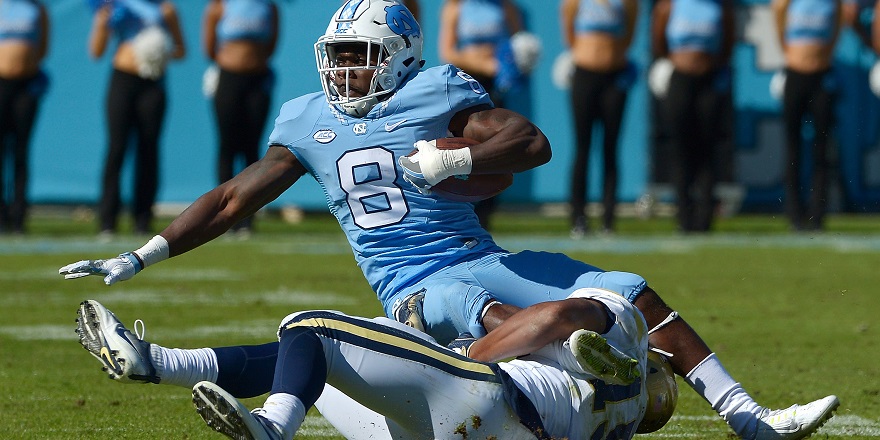
Another RB for the Bengals, Logan is a smaller back that possess game-changing speed and acceleration. Logan has four kickoff returns in his career, and showed reliable hands as a receiver with just one drop on 69 catchable passes. — John Kosko, @PFF_JohnKosko
193. TRADE: Seattle Seahawks from Philadelphia Eagles
[Trade details: Eagles receive Round 3 pick (No. 90 overall) for Round 3 pick (No. 99 overall) and Round 6 pick (No. 193 overall).]
Treston Decoud, CB, Oregon State
The Seahawks add more depth with Treston Decoud, a prototypical lengthy and physical cornerback who can jam receivers at the line of scrimmage. He recorded nine pass breakups and allowed an NFL rating of 77.2 into his coverage in 2016. — Harley Sherman, @PFF_Harley
194. Buffalo Bills
Aarion Penton, CB, Missouri
With a depleted depth chart at the position, the Bills double-dip in the cornerback pool. Penton has concerns regarding his size, speed, and quickness, but was extremely productive at Missouri (25 combined interceptions and pass breakups along with a 55.8 QB rating allowed since 2014), and his ball-hawking skills might be the best on the roster from Day 1. — Billy Moy, @PFF_Billy
195. Detroit Lions from New Orleans Saints
Chad Williams, WR, Grambling
Williams had a big pro day last month, as he ran a 4.43-second 40-yard dash at over 6-foot. His speed shows up on film more than it did at Senior Bowl practices, where he was able to show his ability to separate with solid route running, as well as his ball skills in traffic. — Josh Liskiewitz, @PFF_Josh
196. Arizona Cardinals
Des Lawrence, CB, North Carolina
This draft class is deep with talented cornerbacks, and so I decided to double-dip at the position and draft a second cornerback with the selection of Des Lawrence. Lawrence didn’t allow a touchdown last season and opposing quarterbacks only had a 60.1 QB rating when throwing into Lawrence’s coverage. — Jordan Plocher, @PFF_Jordan
197. San Francisco 49ers from Baltimore Ravens
Jalen Reeves-Maybin, LB, Tennessee
Reeves-Maybin missed 37 tackles over the past three seasons, despite missing much of the 2016 season through injury, but he has the potential to develop in the right system. Athletically gifted, he'll start out of special teams and get a shot on defense if he can clean up his tackling issues. — Gordon McGuinness, @PFF_Gordon
198. Minnesota Vikings

The Vikings added a pair of tackles in free agency, but they would still love to find a young player that could improve the position. Sean Harlow allowed just one sack in 2016 while moving bodies in the run game at Oregon State. — Sam Monson, @PFF_Sam
199. TRADE: New Orleans Saints from New England Patriots via Indianapolis Colts
[Trade details: Patriots receive pick No. 32 overall and Round 3 pick (No. 103 overall), Saints receive CB Malcolm Butler and Round 6 pick (No. 199 overall)]
Although the Saints have acquired Ted Ginn Jr. to replace Brandin Cooks, Ginn is an unreliable deep target due to his drops and cannot be considered a long-term option, as he just turned 32. Gentry can develop to fill this role for the Saints, as he led the nation with 49 targets on deep passes in 2016 and ranked third with 10 touchdown receptions on such passes. —Zoltán Buday, @PFF_Zoltan
200. Washington Redskins
Kenny Golladay, WR, Northern Illinois
Replacing a team’s top two wide receivers is a difficult task. Having made sizable investments in free agency (Terrelle Pryor) and a 2015 first-round pick who has barely played (Josh Doctson), Washington needed to address other positions early in the draft. Golladay is a low-cost option with a high PFF overall grade of 84.2 in 2016. He's a big-bodied receiver who has the size and hands to be a goal-line and deep threat. — Trevor Lynch, @PFF_Lynch
201. San Francisco 49ers from Denver Broncos
Arthur Maulet, CB, Memphis
Maulet isn't polished, but graded very well in coverage last year. Had two interceptions and 11 pass breakups, and allowed an NFL passer rating of just 60.2. He will need to develop, but is a potential sleeper pick in Round 6. — Gordon McGuinness, @PFF_Gordon
202. Denver Broncos from Tennessee Titans
Marquez White, CB, Florida State
In today's NFL, you can never have too much corner depth. White allowed just 302 yards in coverage last season and made some big-time plays. He's not without issues, and will need to improve his tackling and pursuit angles to make it as a pro. — Bryson Vesnaver, @PFF_Bryson
203. Tampa Bay Buccaneers
Keith Brown, LB, Western Kentucky
The Bucs need to replace Daryl Smith and his 475 snaps in 2016. Brown adds a well-rounded skill-set, but should make his biggest contributions in the run game. His size and ability to shed blocks led to 85 tackles and 66 stops this past season. — Bill Douglas, @PFF_Bill
204. Detroit Lions
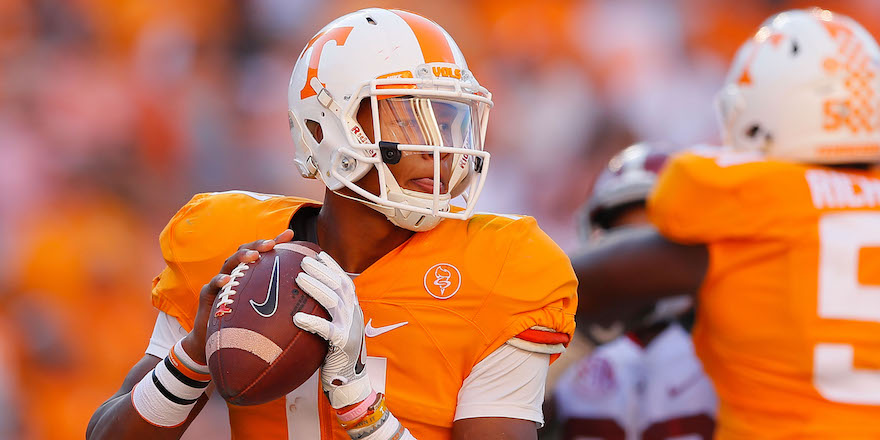
I'm a big believer in taking a late-round QB in every draft regardless of a team's current depth chart, as quality starters are so hard to find and having a solid backup can eventually lead to major draft capital. Dobbs finished his senior season with a streak of five strong games, as he posted a QB rating over 115.0 in four of them while throwing for 12 touchdowns and just one interception. — Josh Liskiewitz, @PFF_Josh
205. Miami Dolphins
Coming off a torn ACL in bowl preparation, Beckwith had his stock fall by a round or two. With a big frame and high football IQ, Beckwith could compete for time at the SAM linebacker position for the Dolphins. He'll have to cut down on his missed tackles at this level, as he missed 39 of them in three seasons with LSU. — Steve Slowik
206. TRADE: Denver Broncos from New York Giants
Gabe Marks, WR, Washington State
[Trade details: Giants receive Round 2 pick (No. 51 overall), Broncos receive Round 2 pick (No. 55 overall) and Round 6 pick (No. 206 overall)]
The Broncos need a slot receiver to take the load off of Demaryius Thomas and Emmanuel Sanders. Marks is a great route runner and has good hands that should allow him to succeed in the slot. He averaged 2.35 yards per route run from the slot last season. — Bryson Vesnaver, @PFF_Bryson
207. Oakland Raiders
The interior of the Raiders' defensive line was a nightmare in 2016. Walker was expected to be a high draft pick before a troubling senior year where he left the team after an injury. In 2015, though, Walker graded higher than teammate Charles Tapper, who went in the fourth round of the 2016 NFL Draft. — Mike Renner, @PFF_Mike
208. Houston Texans from Washington Redskins
Devonte Fields, Edge, Louisville
Devonte Fields flashes great agility and burst off the edge, and should be able to contribute as a situational pass-rusher early on in his career for the Texans. In 2016, Fields picked up 36 total QB pressures and posted a healthy 10.0 pass-rushing productivity (PRP) mark. His 21.6 PRP in the fourth quarter of games was the second-best mark in this draft class. — Vinnie Ronca, @PFF_Vinnie
209. Seattle Seahawks
Tim Patrick adds raw athleticism to the Seahawks' WR corps, and most importantly, a potential deep threat that Russel Wilson has been lacking. 34.1 percent of his targets came on passes that traveled at least 20 yards in the air in 2016. — Harley Sherman, @PFF_Harley
210. Dallas Cowboys
Brandon Wilson, CB, Houston
While he may be flying under the radar, Brandon Wilson can simply do it all. Starting 29 games over the last three seasons, the Cougars were awarded in 2016 as they saw Wilson reduce his yardage allowed per coverage snap at cornerback from a solid 1.37 in 2015 to a standout 1.06. Wilson also excelled returning kickoffs over the last two seasons, averaging 26.8 yards per return. In addition, when starting RB Kenneth Farrow was injured in 2015, Wilson stepped in to rush for 188 yards on 38 carries. He posted a stellar 79.2 elusive rating during that time and will offer the Cowboys valuable versatility on day one with the franchise. — Wes Huber, @PFF_Wes
211. Green Bay Packers
Robert Davis, WR, Georgia State
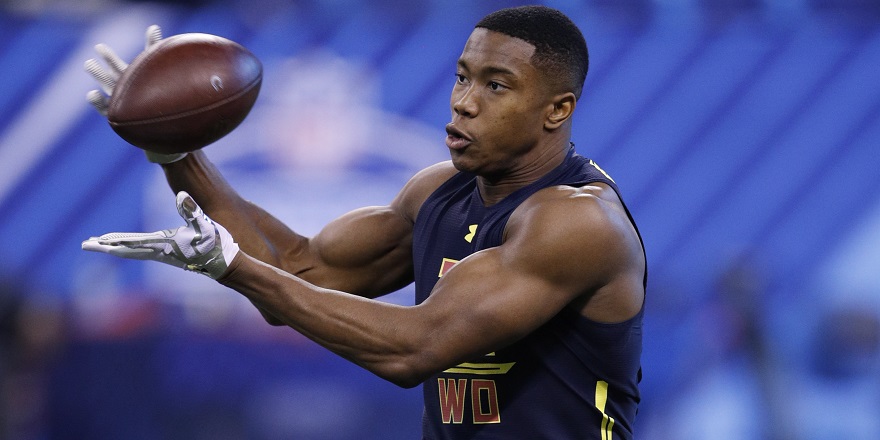
Davis is as raw as can be coming out of Georgia State, but he has elite physical traits. The Packers have shown an ability over the years to develop receivers, and Davis certainly qualifies as a project. — Mike Renner, @PFF_Mike
212. Pittsburgh Steelers
The production wasn't there at LSU for many reasons, but Dural's natural game speed to get down the field makes him an intriguing late-round option for the Steelers. — Zac Robinson, @Zac_Robinson5
213. Tennessee Titans from Atlanta Falcons
Carroll Phillips, Edge, Illinois
Phillips did not post off-the-chart production at Illinois as an undersized defensive end, but is expected to transition to outside linebacker at the next level. Despite his inexperience, during Senior Bowl week he showed promise in coverage against tight ends, and his 39 total QB pressures from 2016 are also encouraging. — Josh Liskiewitz, @PFF_Josh
214. Detroit Lions from New England Patriots
Jeremy Clark, CB, Michigan
Clark looked to be on his way to a solid senior season in 2016 before tearing his ACL on special teams in Week 4 against Penn State. At 6-foot-3 and 220 pounds, he posted the second-most bench reps among combine CBs, with 20, and on eight targets against last season, he gave up just three receptions for a total of 15 yards. — Josh Liskiewitz, @PFF_Josh
215. Kansas City Chiefs (compensatory selection)
Clark missed just 19 of 230 attempted tackles in three seasons. He's better off in the box or in the slot, and was a consistent player in college who could see snaps in dime formation. — Mark Harrington, @PFF_Mark
216. Cincinnati Bengals (compensatory selection)
Jonnu Smith, TE, Florida International
Smith is an athletic TE that has forced double-digit missed tackles each of past three seasons, but shows inconsistent hands with 14 drops the past two years. He will need to adjust to the size and speed of NFL defenses, but should contribute on special teams early in his career. — John Kosko, @PFF_JohnKosko
217. Kansas City Chiefs (compensatory selection)
Williams ran a 4.41-second 40-yard dash at the combine, second-fastest among running backs, demonstrating the ability to outrun almost everyone. Ball security is an issue, with seven fumbles on 322 carries, as well not being much of a threat in the passing game. — Mark Harrington, @PFF_Mark

218. San Francisco 49ers from Cleveland Browns
Damore’ea Stringfellow, WR, Mississippi
Rounding out their draft class, the 49ers take a flier on the Ole Miss wide receiver. There's inconsistency there, with 10 drops from 56 catchable passes in 2016, but Stringfellow is a big, physical receiver who can do damage after the catch. — Gordon McGuinness, @PFF_Gordon
219. Washington Redskins from San Francisco 49ers
Jeremiah Ledbetter, DI, Arkansas
Building a stalwart defensive line in this draft already in players who can contribute on day one allowed some flexibility to roll the dice on a player with the frame, but who is still raw. Ledbetter lacks the developed moves in his arsenal for pass-rushing consistency, but with the hiring of defensive line coach Jim Tomsula, this looks to be a mutually beneficial pick for both team and player to build on a vastly-improved pass-rush grade at Arkansas (from 51.8 in 2015 to 74.1 in 2016). — Trevor Lynch, @PFF_Lynch
220. Chicago Bears
I’Tavius Mathers, RB, Middle Tennessee
Mathers, a former Ole Miss transfer, had an exceptional year for MTSU. His 85 missed tackles forced were the third-most in the nation, his 28 runs of 15-plus yards ranked fifth, and he had the third-most receiving yards (625) for a running back. Mathers' skill-set complements No. 1 back Jordan Howard well. — Matt Claassen, @PFF_Matt
221. Jacksonville Jaguars
This is a talented and deep tight end class, so I selected a second one here for the Jaguars. Hikutini is a move tight end and hopefully a mismatch player for the Jaguars in the pass game. 10 of Hikutini’s 50 receptions in 2016 came from the slot. — Jordan Plocher, @PFF_Jordan
222. Miami Dolphins from Los Angeles Rams
Keion Adams, Edge, Western Michigan
Adams had his most productive year in 2016, recording seven sacks and 38 quarterback hurries. At 6-foot-02, 245 pounds, Adams may lack the size and length to be an every-down edge player, but could find a way onto the field in sub packages to be a situational pass-rusher. — Steve Slowik
223. TRADE: Philadelphia Eagles from New York Jets
[Trade details: Eagles receive Round 2 pick (No. 39 overall) and Round 7 pick (No. 223 overall), Jets receive Round 2 pick (No. 43 overall) and Round 5 pick (No. 154 overall)]
Calvin Munson, LB, San Diego State
The Eagles' one-gap scheme puts significant pressure on the linebackers to shed blocks. Munson loves to mix it up physically, using his aggression to fly to the ball. He will make an excellent special teamer at a minimum, and could contribute in base and goal-line packages as a rookie. — John Breitenbach, @PFF_John
224. Los Angeles Chargers
The Chargers select a developmental offensive tackle in David Sharpe. With a huge frame, Sharpe certainly looks the part, but his play hasn’t been great. That said, he recorded a career-best 77.5 pass-blocking grade in 2016, and has tools to work with. He's worth a roll of the dice in the seventh round. — Kevin Connaghan,@PFF_Kev
225. Seattle Seahawks from Carolina Panthers
Woody Baron, Edge, Virginia Tech
Baron projects as a movable chess piece along the Seahawks' defensive front, with experience playing both head against nose tackles and as a stand-up rusher. He finished 2016 with 26 total QB pressures. — Harley Sherman, @PFF_Harley
226. Cincinnati Bengals
A two-year starter at WR after converting from DB, Lane provides excellent athleticism with a raw repertoire at the WR position. If developed correctly, Lane shows the ability to attack the ball in the air and the size to assist in the running game and red zone. — John Kosko, @PFF_JohnKosko
227. Dallas Cowboys from Buffalo Bills
Chris Odom, Edge, Arkansas State
After filling a reserve role through the 2015 season, Chris Odom pushed forward in a big way last season after earning a starting role. Odom produced 63 total quarterback pressures in 2016 that generated the sixth-best pass rush productivity among all 4-3 defensive ends (13.6) and added 24 run stops for the fourth-best run-stop percentage (8.4) in the NCAA. — Wes Huber, @PFF_Wes
228. New Orleans Saints
Running back and interior offensive line depth were both considered at this point, but with several veteran running backs still available and defensive line being a bigger need, the Saints go with D.J. Jones here. The former Ole Miss defender took a step back in 2016, but could still provide good depth as an interior defender, especially based on his 2015 season when he recorded 25 defensive stops and did not miss a single tackle. —Zoltán Buday, @PFF_Zoltan
229. Philadelphia Eagles
Brandon Radcliff, RB, Louisville
After missing out on a runner earlier in the draft, the Eagles round out their class with some help for the backfield. Radcliff can fill Ryan Mathews' role if he is released as expected. The former Louisville Cardinal uses impressive power to break tackles, suggesting he could thrive on early downs and in short yardage. — John Breitenbach, @PFF_John
230. Arizona Cardinals
Shalom Luani, S, Washington State
The Cardinals value physicality from their safeties, and Luani fits that bill. Luani willingly hits people, and his run-stop percentage of 6.1 ranks sixth in the class. He will start out on special teams. — Jordan Plocher, @PFF_Jordan
231. Minnesota Vikings
Zach Terrell, QB, Western Michigan
QBs are so valuable that I would always roll the dice on one late in the draft, because the jackpot payoff is so huge if you get it right. Zach Terrell showed some ability at Western Michigan and would be an intriguing developmental QB. — Sam Monson, @PFF_Sam
232. Carolina Panthers from Indianapolis Colts via Cleveland Browns
Jones rebounded after missing all but 14 snaps of the 2015 season with an extremely productive final season for the Fighting Irish. Jones run-stop percentage of 10.4 was fifth-best in this draft class among DTs/NTs, with his two best and most productive displays coming against Miami (86.8 overall grade; seven stops) and Virginia Tech (82.2 overall grade; eight stops). — Ben Stockwell, @PFF_Ben
233. Los Angeles Rams from Baltimore Ravens
The Rams add a strong-armed, athletic quarterback with experience playing under center. Beathard will compete with Aaron Murray and Sean Mannion to back up Jared Goff. — Kiernan Hogan,@PFF_Kiernan
234. Houston Texans from Washington Redskins
Xavier Su’a-Filo and Jeff Allen each graded out among the league’s worst guards last season, so the Texans look to add an infusion of young talent at the position with LSU’s Josh Boutte. In 2016, Boutte had a solid 82.9 run-blocking grade and surrendered just eight total pressures on 283 pass-blocking snaps. He wasn’t much of an impact blocker in college, but his consistency with positioning helped ensure that he limited negative plays. — Vinnie Ronca, @PFF_Vinnie
235. Tennessee Titans
Tupou fell to the end of the draft because he lacks pass-rushing ability, but he is a mountain of a man to move on run plays. He played 524 of 594 snaps last season from a traditional nose tackle position, and posted a solid 21 run stops. — Josh Liskiewitz, @PFF_Josh
236. Tampa Bay Buccaneers
The Buccaneers add Brantley's counterpart, who put up solid numbers despite playing out of position at NT (four sacks, seven hits, 13 hurries, and 16 stops). He won't need to produce right away, but will add some needed youth to the interior where the Bucs have had injury issues the last few years. — Bill Douglas,@PFF_Bill
237. Denver Broncos
Providing more potential nose tackle depth/competition for the Broncos, Myers offers next-to-nothing in terms of pass rush, but as a run-stuffing nose tackle, he could be a force. Last season, he finished with 33 solo run stops, eighth-most in the nation among defensive tackles. — Bryson Vesnaver, @PFF_Bryson
238. New England Patriots from Detroit Lions
Jordan Westerkamp, WR, Nebraska
Westerkamp is extremely quick, built in the mold of former Patriot legend Wes Welker, running 94.8 percent of his routes out of the slot. He battled injuries in 2016, but had no drops on 38 catchable balls thrown his way and averaged 7.0 yards after catch per reception. He may end up on the practice squad to start his career, but there is a clear fit here if he can develop behind Edelman and Amendola. — Louie Benjamin, @PFF_Louie
239. Miami Dolphins
Newly-signed T.J. McDonald will miss the first eight games of the season due to suspension, so with their final pick, the Dolphins add safety depth with Jadar Johnson. Johnson is instinctive in coverage with great ball skills, as opposing quarterbacks had a passer rating of 47.1 when throwing at him in 2016. He also recorded five interceptions. — Steve Slowik
240. New York Giants
YoungHoe Koo, K, Georgia Southern
With Robbie Gould leaving in free agency, the Giants need a new kicker. Koo was one of two kickers last year with 20-plus attempts and a field-goal percentage of 95 or better. — Nathan Jahnke,@PFF_NateJahkne
241. Oakland Raiders
The Raiders add another body along the defensive line. Rochell was out of place playing outside the tackles at Notre Dame and could have more of an impact in the NFL playing on the interior. — Mike Renner, @PFF_Mike
242. Houston Texans
Mike Tyson, CB, Cincinnati
Tyson came out swinging last season and was the second-highest-graded corner in the nation through the first four weeks. His play dropped off some as the season progressed, but he still finished with a solid five interceptions, seven pass breakups, and a 65.5 QB rating allowed into his coverage. He may have been selected in the final round, but Tyson’s bare-knuckle style of play gives him a fighter’s chance at making this Texans roster. — Vinnie Ronca, @PFF_Vinnie
243. Oakland Raiders from Seattle Seahawks
Gunner Kiel, QB, Cincinnati
Before Kiel crashed and burned as a senior at Cincinnati, he was getting mid-round hype as a quarterback prospect. There is still a fairly sizable skill-set here, it just needs to be harnessed in the right situation. — Mike Renner, @PFF_Mike
244. Kansas City Chiefs
Cethan Carter, TE, Nebraska
The Chiefs grab a TE with their final pick. Carter dealt with injuries and drops last season. Among draft-eligible TEs, Carter graded out as the fifth-best run blocker, which is something the Chiefs value in multiple-TE sets. — Mark Harrington, @PFF_Mark
245. Dallas Cowboys
Aaron Jones, RB, UTEP
It may come as a surprise, but over the last three seasons, RB Aaron Jones has generated the second-highest yards after contact per attempt mark (3.82) in this absolutely loaded running back class. Add in the fact that he also generated the ninth-best average yards per receiving route run mark (1.84) and sixth-highest percentage of rushing yardage produced on 15-plus yard runs, and it becomes entirely clear that Jones will have a great opportunity to join Dallas' roster as an eventual No. 2 back behind superstar Ezekiel Elliott. — Wes Huber, @PFF_Wes
246. Green Bay Packers
Green Bay couldn't leave the draft without trying to turn a college tackle into a guard, and Holden is as good a project as any. — Mike Renner, @PFF_Mike
247. Pittsburgh Steelers
Joshua Holsey, CB, Auburn
Holsey's injury history worries many, but he is a playmaking corner from a top program. He allowed just a 49.3 passer rating into his coverage this past season. — Zac Robinson, @Zac_Robinson5
248. Atlanta Falcons
Isaiah McKenzie, WR, Georgia
One of the top return threats in the nation, McKenzie might not feature a lot on offense, but is worth a flyer at this stage after Eric Weems departed in free agency. — Khaled Elsayed, @PFF_Khaled
249. Detroit Lions from New England Patriots
Dylan Bradley, DI, Southern Mississippi
Bradley wins with explosion off the ball, and while he weighs just 265 pounds, he has the capability of rushing from the interior. In just 350 pass-rush reps last season he posted a total of 37 QB pressures. — Josh Liskiewitz, @PFF_Josh
250. Cincinnati Bengals (compensatory selection)
Trevon Hester, DI, Toledo
Hester has graded well for the Toledo Rockets the past three seasons and has the skill-set to fill in multiple positions on the defensive line. He posted the 21st-best pass-rushing productivity, at 8.2, while also recording the 12th-best mark in run-stop percentage, at 10.1, in the draft class. — John Kosko, @PFF_JohnKosko
251. Denver Broncos (compensatory selection)
Leggett offers tight end depth as a receiving threat, not as a blocker. That said, he has some impressive hands and could develop into a receiving weapon down the road. He played over 68 percent of his snaps from the slot last season and averaged 1.53 yards per route run. — Bryson Vesnaver, @PFF_Bryson
252. Denver Broncos (compensatory selection)
Dalton Crossan, RB, New Hampshire
Crossan is a depth draft pick out of New Hampshire, but gives the Broncos a potential offensive/special teams weapon. He racked up 5,189 all-purpose yards and 36 total touchdowns through four seasons with the FCS team. — Bryson Vesnaver, @PFF_Bryson


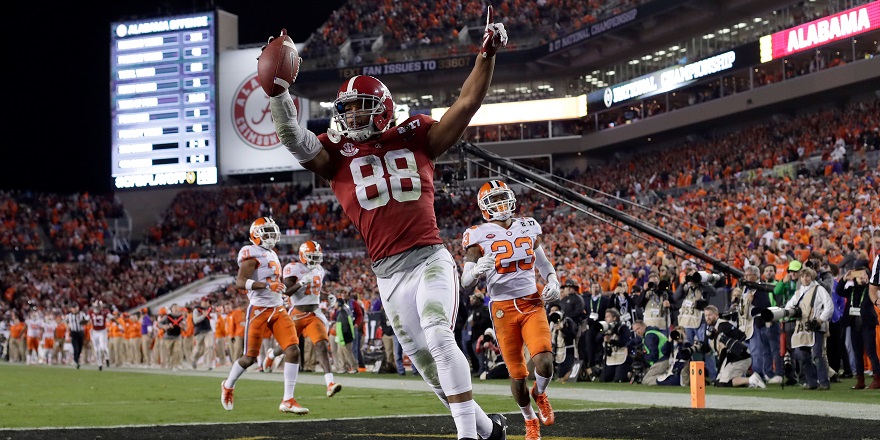

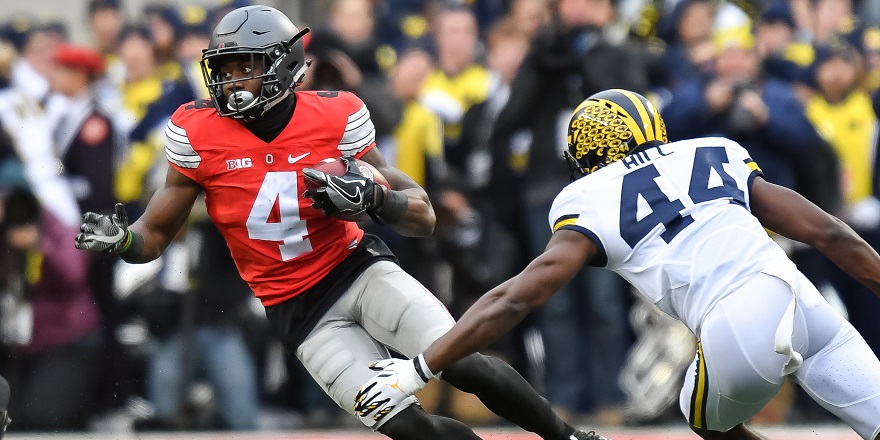
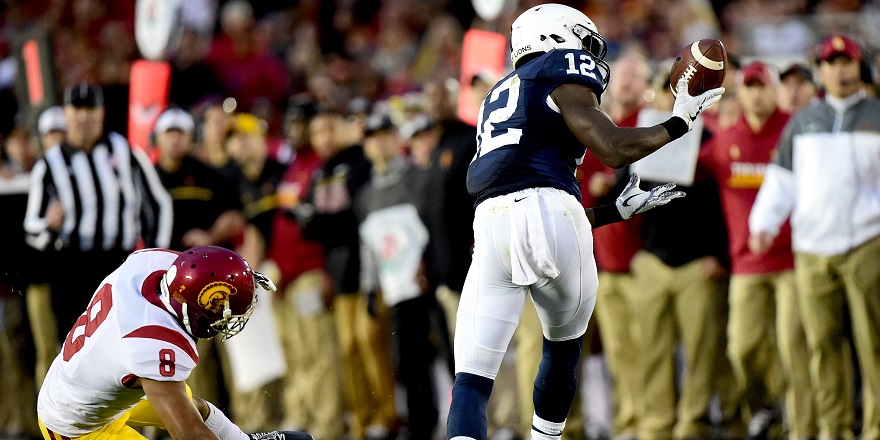
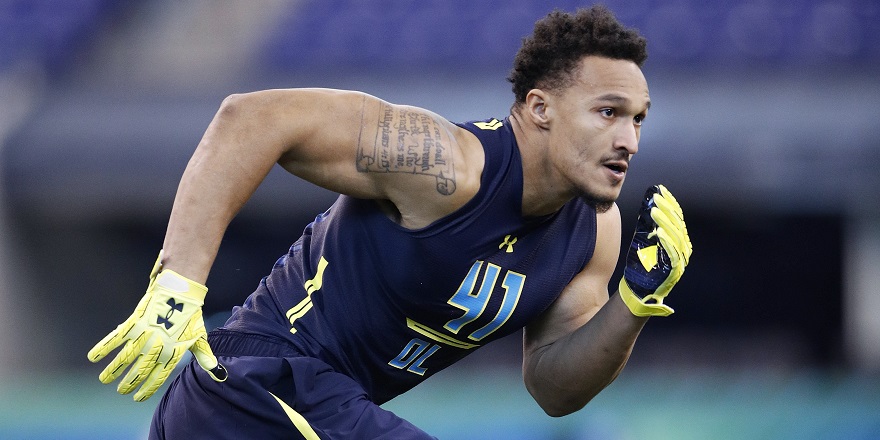
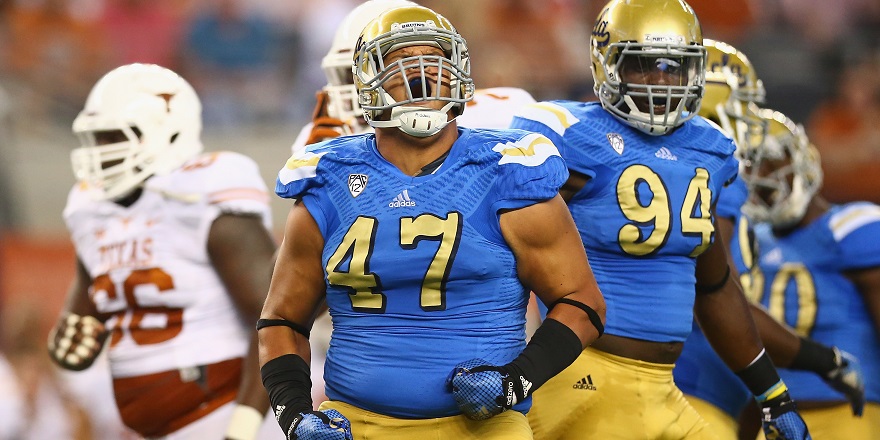
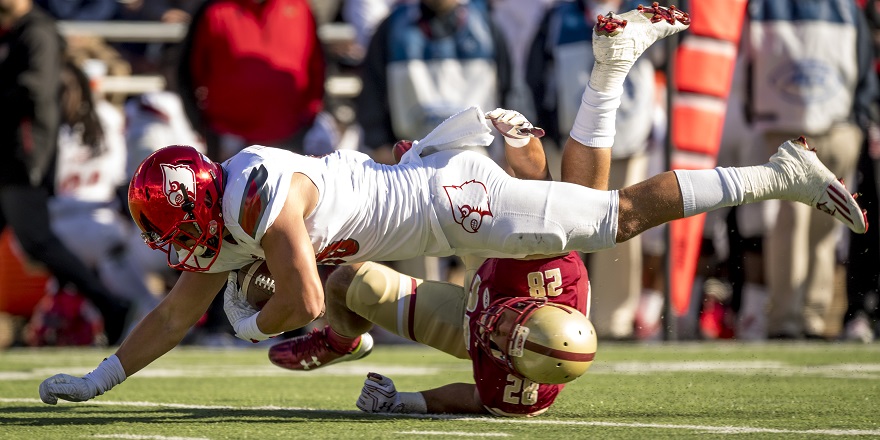
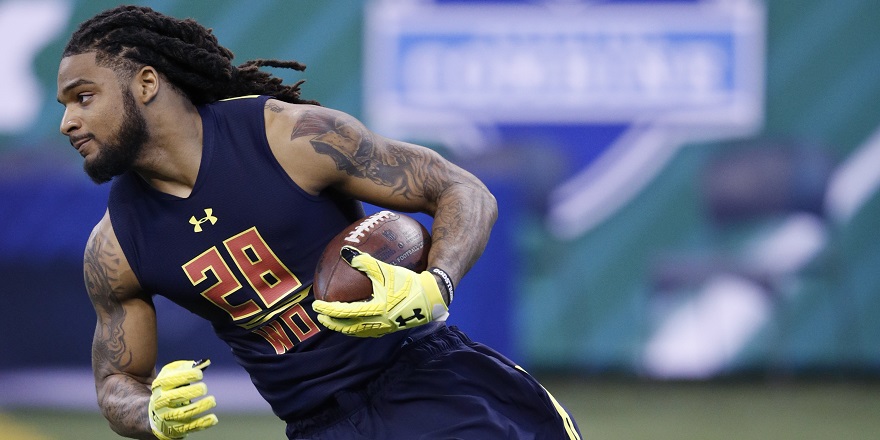

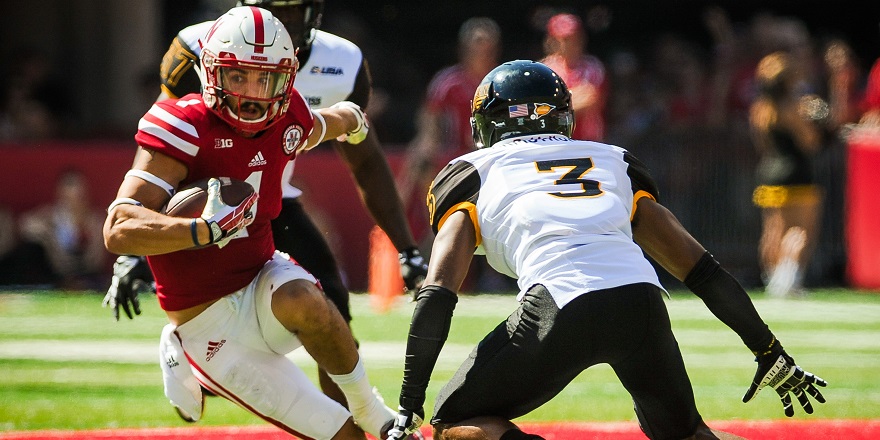

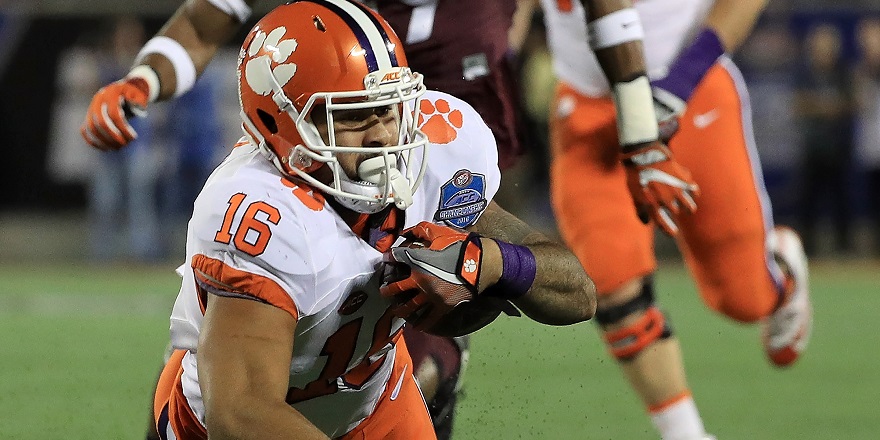


 © 2025 PFF - all rights reserved.
© 2025 PFF - all rights reserved.